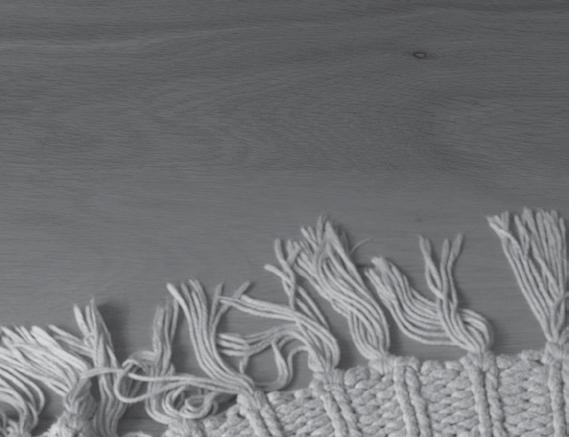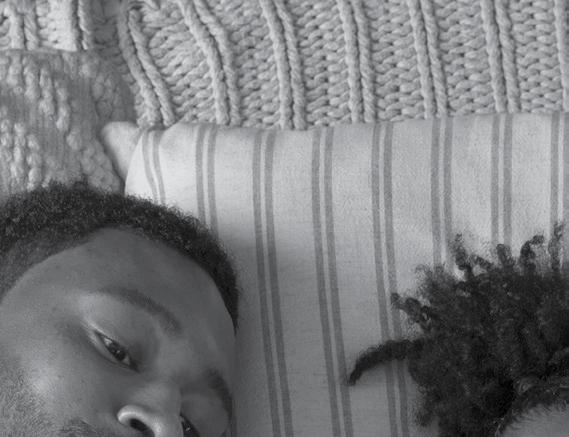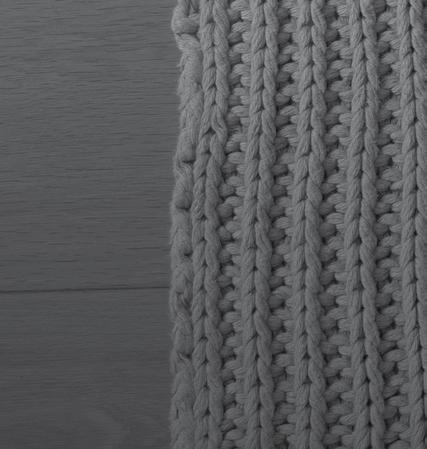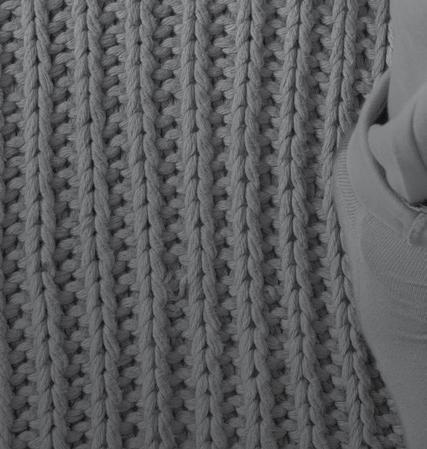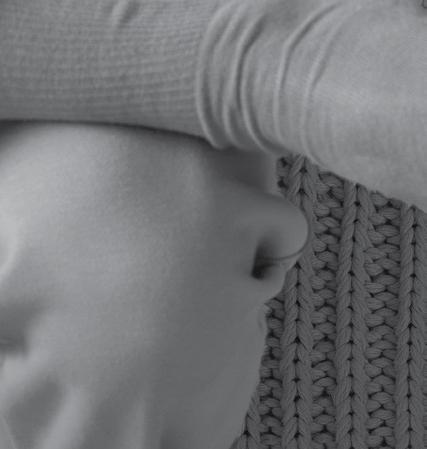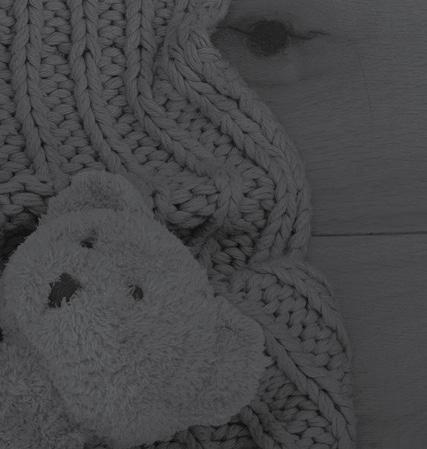




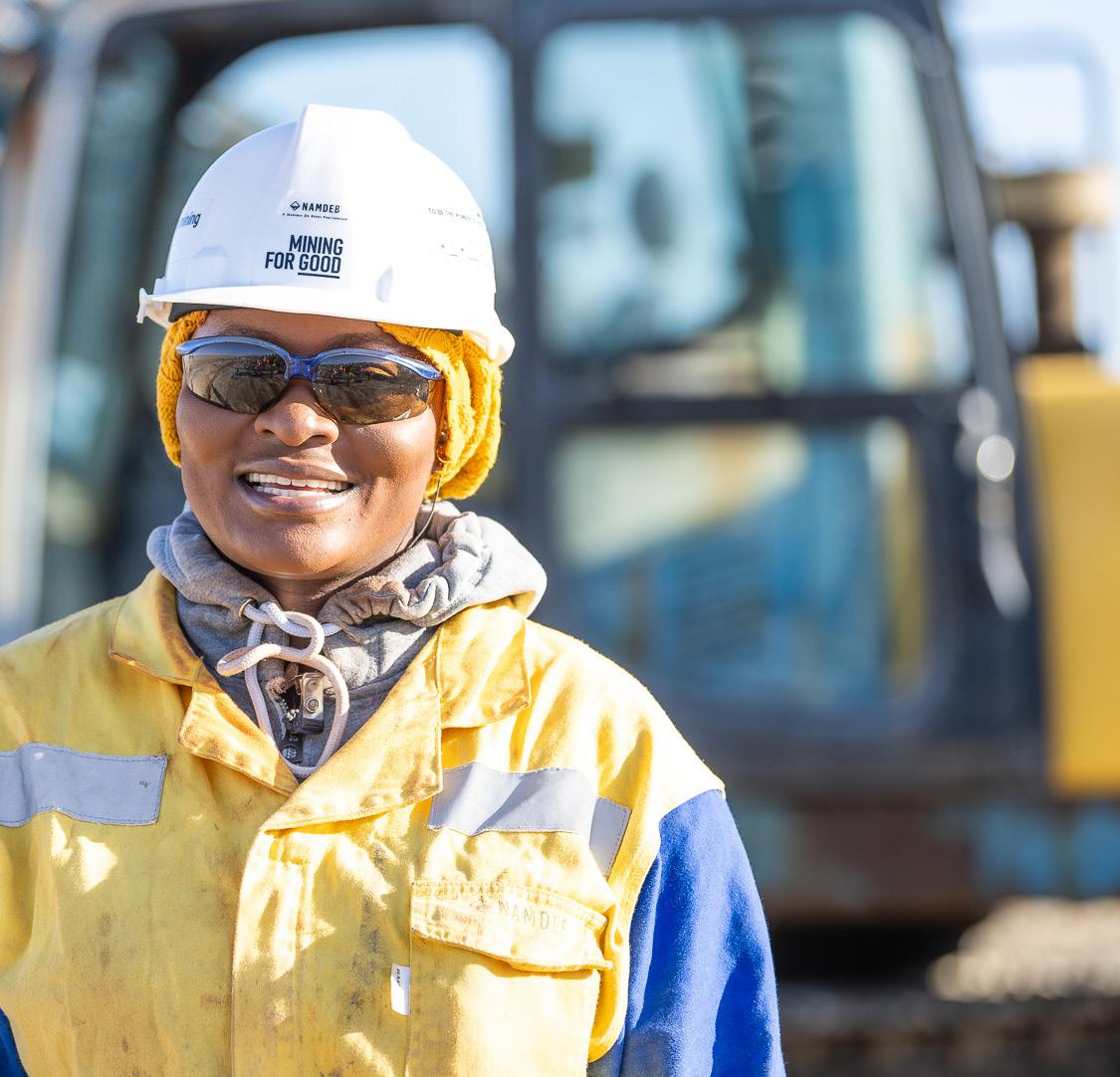
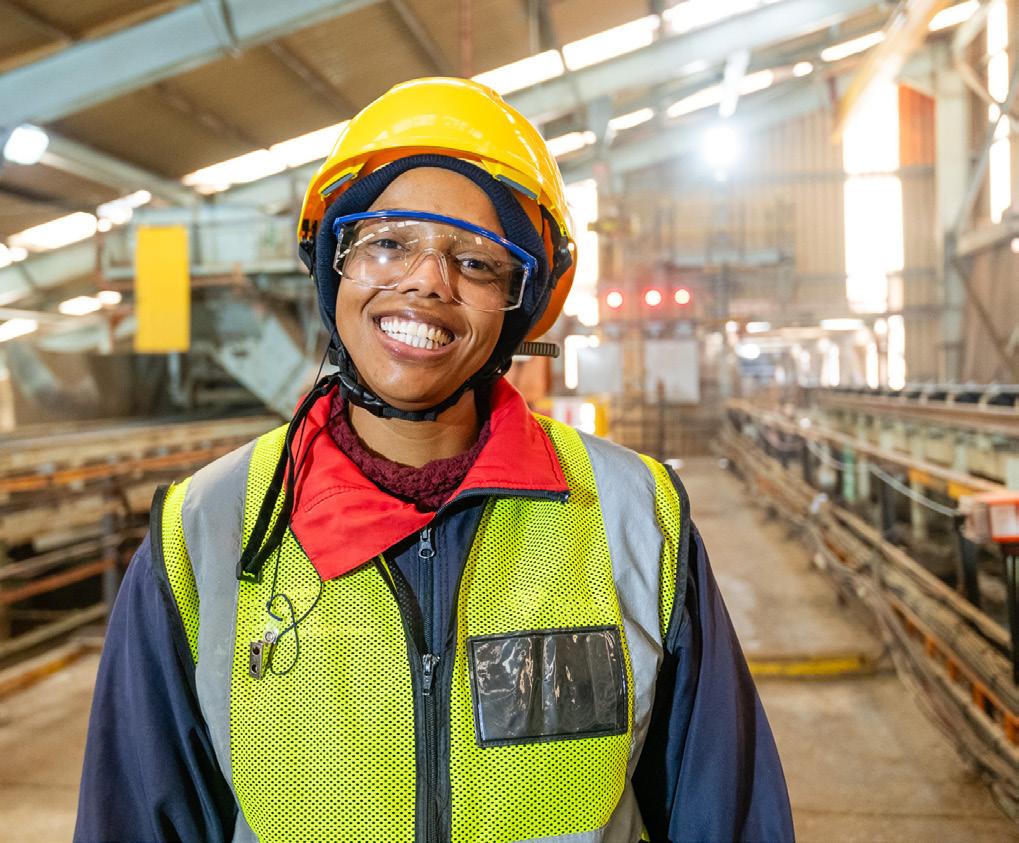

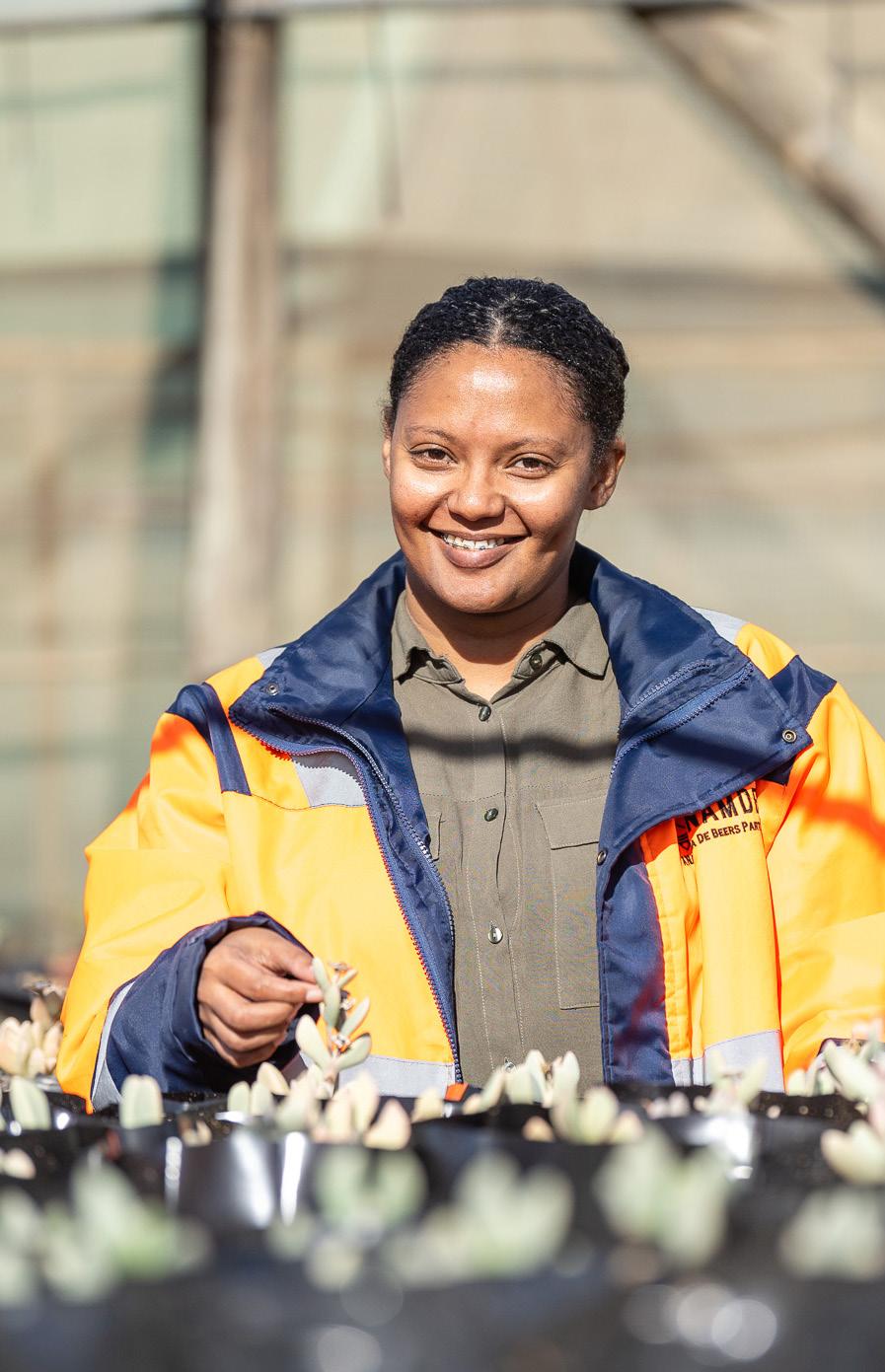

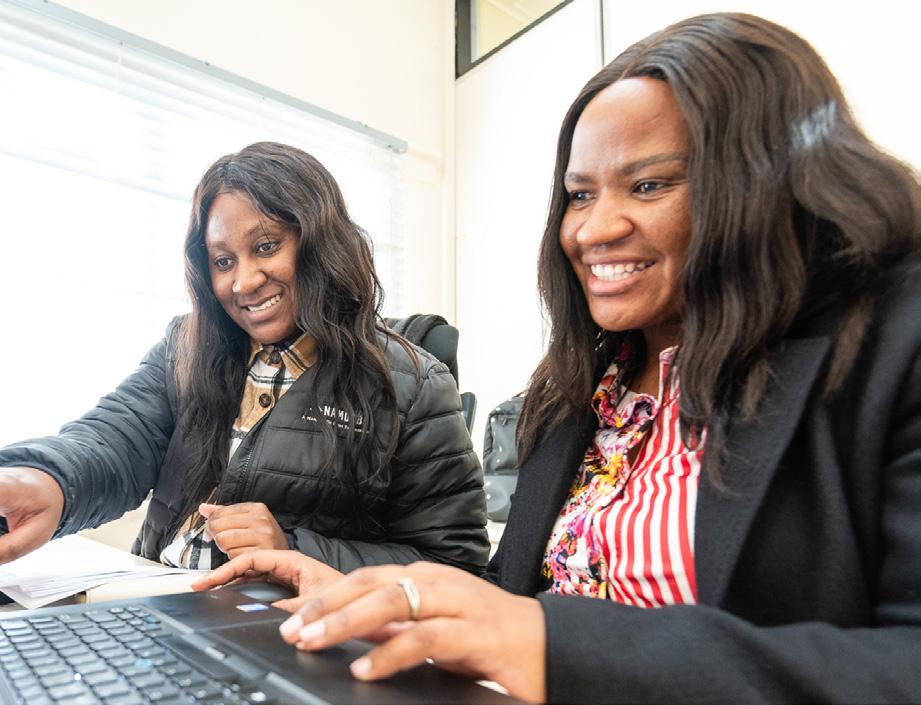

We enable an inclusive environment for enhanced career prospects, focusing on accelerating equal opportunities for all.
At Namdeb, we are about more than mining. We are about mining for good.


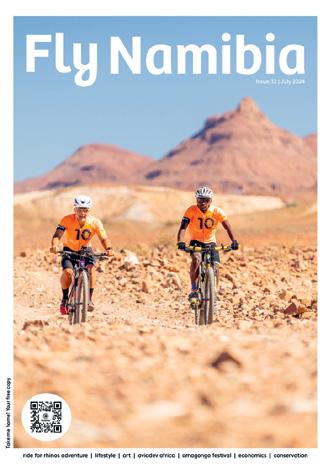

- Fyodor Dostoevsky




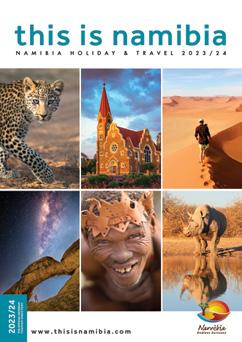

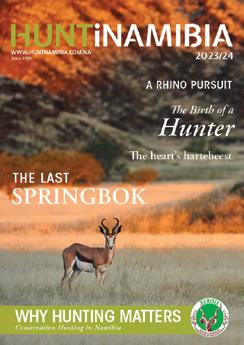


Meet the voices behind the incredible stories we share with Namibia each month. The pages of FlyNamibia are a collaboration of Namibian minds and passions and we hope you find a narrative that speaks directly to you amongst them.

Kirsty Watermeyer
Media and communication consultant, storyteller and writer. A Multi-media producer, presenter, voice artist and curious wellbeing enthusiast.

A Windhoek-based communications specialist, blogger and freelance fashion writer. Contact her via email: rukeekaakunga@gmail.com

David Bishop
Media commentator and critic, climbing wall owner, voracious reader, sometime writer, active lifestyle proponent, family man, and coffee lover.

Charene Labuschagne
Art director, writer and presenter, she tells stories out of pure necessity for expression. Namibia is her favourite subject.

Zane Feris Research Analyst at IJG Securities

An aspiring astronomer, who enjoys gazing at the stars and sharing science research stories.


Dr Marelise Calitz
Educational
Psychologist
“It is extremely more stressful to send your child to Grade 1 than to University.”






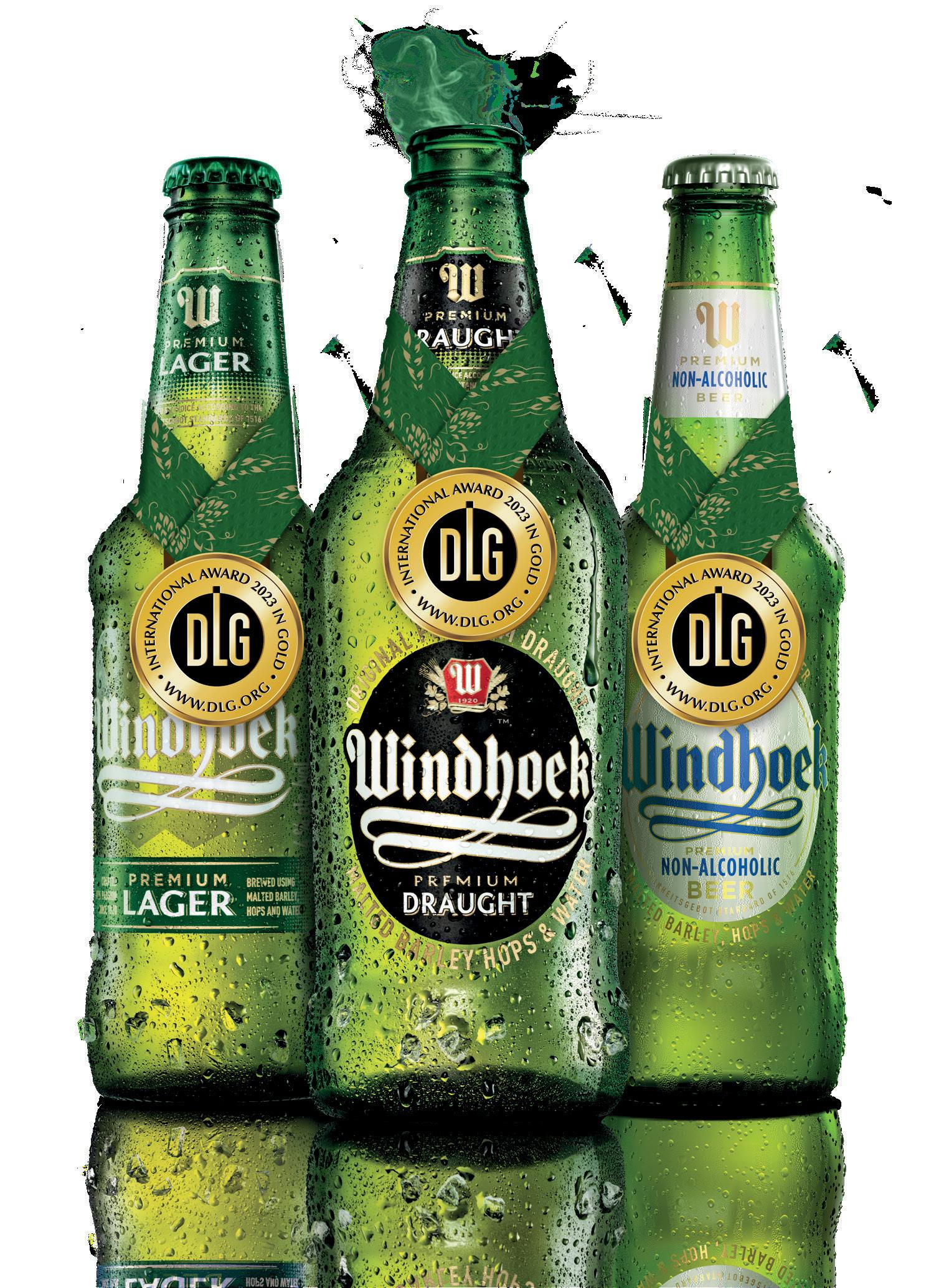
Select which tickets you would like to purchase: destinations, travel dates, morning/afternoon departure. We offer multiple fare options such as: Saver, Classic or Premium
Please enter names as they appear on passport or travel documentation
LOGIN to upload passenger details from previous booking.
More options for the perfect trip
Baggage policy, sporting equipment, over weight luggage or to add an additional bag(s)
Cash payment at: Eros Airport, Ondangwa Airport, Oranjemund Airport
Online card transaction
Electronic Funds Transfer (EFT)
PayToday app Buddy SuperApp
Online check-in opens 24 hours before departure of the flight on Fly Namibia
Check-in opens 1h 30min before domestic flight and 2 hours before international flight.
Check-in CLOSES 30 min prior to domestic flight and 50 min prior to international flight.
flight information / rules
Read up on all our additional information regarding terms and conditions, and tick the selection box once completed to continue.
Fill in your payment details in our DPO paygate to make final payment.
Transaction confirmation will be sent to passenger email entered.
Windhoek Eros Airport Office
Ondangwa airport office
Rundu airport office
Katima Mulilo airport office
Hosea Kutako airport office
All major travel agents
Items NOT allowed in hand luggage:
Lotions and aerosols above 100ml, flammable aerosol, sharp objects, i.e. nail files, nail scissors, Leatherman, matches.
20kg Per person





DEPARTURE FROM TO ARRIVAL DAYS
06:30 Eros - Windhoek
08:00
Ondangwa - Toivo Ya Toivo
16:20 Eros - Windhoek
17:50
Ondangwa - Toivo Ya Toivo
10:15 HKIA - Windhoek
12:55 Katima Mulilo
09:40 Eros - Windhoek
11:20 Oranjemund

Ondangwa - Toivo Ya Toivo 07:30 Mon, Tue, Fri
Eros - Windhoek 09:00 Mon, Tue, Fri
Ondangwa - Toivo Ya Toivo 17:20 Tue, Wed, Thu, Fri, Sun
Eros - Windhoek 18:50 Tue, Wed, Thu, Fri, Sun
Katima Mulilo 11:40 Wed, Fri, Sun
HKIA - Windhoek 14:15 Wed, Fri, Sun
Oranjemund 10:40 Mon, Thu
Eros - Windhoek 12:20 Mon, Thu
13:00 Eros - Windhoek Lüderitz 14:00 Mon, Tue, Thu
14:40 Lüderitz
Eros - Windhoek 15:40 Mon, Tue, Thu
DEPARTURE FROM TO ARRIVAL DAYS
10:15 HKIA - Windhoek Victoria Falls 11:45 Tue, Thu, Sat
12:45 Victoria Falls HKIA - Windhoek 14:15 Tue, Thu, Sat
From 3 July 2024 - 31 October 2024
10:15 HKIA - Windhoek Maun 11:15 Wed, Fri, Sun 11:55 Maun HKIA - Windhoek 14:15 Wed, Fri, Sun
in Partnership with

14:00 Cape Town Walvis Bay 16:15 Mon, Tue, Wed, Thu, Fri, Sun
16:50 Walvis Bay Cape Town 19:00 Mon, Tue, Wed, Thu, Fri, Sun
12:05 Cape Town Walvis Bay 14:20 Sat
14:55 Walvis Bay Cape Town 17:05 Sat
06:20 Cape Town

HKIA - Windhoek 08:35 Mon, Tue, Wed, Thu, Fri
09:25 HKIA - Windhoek Cape Town 11:35 Mon, Tue, Wed, Thu, Fri
10:45 Cape Town
HKIA - Windhoek 13:00 7 days a week
13:45 HKIA - Windhoek Cape Town 15:55 7 days a week
17:10 Cape Town
HKIA - Windhoek 19:25 Thu, Fri, Sun
07:00 HKIA - Windhoek Cape Town 09:10 Mon, Fri, Sat
DEPARTURE FROM TO ARRIVAL
10:00 HKIA - Windhoek Keerweder 10:55 Mon, Wed, Fri, Sat
11:20 Keerweder Swakopmund 12:10 Mon, Wed, Fri, Sat
12:50 Swakopmund Twyfelfontein 13:30 Mon, Wed, Fri, Sat
14:00 Twyfelfontein Ongava 14:40 Mon, Wed, Fri, Sat
15:05 Ongava Mokuti 15:30 Mon, Wed, Fri, Sat
16:00 Mokuti
HKIA - Windhoek 17:00 Mon, Wed, Fri, Sat
10:00 HKIA - Windhoek Mokuti 11:00 Tue, Thu, Sun
11:30 Mokuti Ongava 11:55 Tue, Thu, Sun
12:20 Ongava Twyfelfontein 13:00 Tue, Thu, Sun
13:30 Twyfelfontein
14:10 Tue, Thu, Sun
14:50 Swakopmund Keerweder 15:40 Tue, Thu, Sun
16:05 Keerweder HKIA - Windhoek 17:00 Tue, Thu, Sun
07:30 Eros - Windhoek Rundu 09:00 Mon, Wed, Fri
16:00 Rundu Eros - Windhoek 17:30 Mon, Wed, Fri
*HKIA - Hosea Kutako International Airport



Dear Passenger,
As you settle into your seats and prepare for your journey, we at FlyNamibia extend our warmest welcome. We are delighted to have you aboard and are excited to share our latest route additions and exciting upcoming ventures with you.
Hello Maun!
On the 3rd of July, the first FlyNamibia Embraer touched down at Maun International Airport. The launch of our newest route, between Windhoek, Namibia, and Maun, Botswana, marks yet another exciting expansion in regional air travel. The inaugural flight heralded a new era of exploration for travellers seeking to experience the heart of Africa's untamed beauty.
This new connection makes it easier than ever for travellers to explore two of southern Africa's most iconic landscapes - from the lush waterways of the Okavango Delta to the striking desert landscapes of Namibia.
The Windhoek-Maun route is set to enhance tourism and foster stronger ties between Namibia and Botswana. It offers a convenient travel option for tourists, wildlife enthusiasts, and business travellers, facilitating a more connected and accessible travel experience within the region. The new route also underscores FlyNamibia's commitment to expanding its network and providing passengers with more travel opportunities.
The route will be operated seasonally (from July to October each year) and will follow an innovative flight routing system designed to enhance connectivity between Windhoek (Hosea Kutako International Airport), Maun, and Katima Mulilo. Select flights will follow the route: Windhoek (Hosea Kutako International Airport) to Maun to Katima Mulilo and back to Windhoek (Hosea Kutako International Airport), on designated days.
Making your stuff Fly!
FlyNamibia is excited to introduce our new cargo services, designed to make transporting goods across Namibia and
southern Africa easier than ever. Whether you're shipping everyday items, urgent packages, or even your beloved pets, we've got you covered. Operational between all airports we service, FlyNamibia Cargo will allow you to let your stuff fly across Namibia and our wider network from airport to airport.
Our general cargo services handle everything from fashion goods and mining equipment to household items. Need something delivered fast? Our express service guarantees quick and reliable delivery, perfect for those last-minute shipments. Got a furry friend? Our live animal transport services prioritise their comfort and safety, adhering to all necessary regulations.
If you're shipping perishable goods like fresh flowers, food products, or seafood, we offer special temperature-regulated storage to keep everything fresh. Valuable and vulnerable items receive extra security and attention to ensure they arrive safely. We also handle the delicate task of transporting human remains with the utmost care and respect, ensuring everything is managed smoothly and compassionately.
With competitive rates and a commitment to customer satisfaction, FlyNamibia Cargo is your go-to solution for all air freight needs. For more information or to book a service, visit our website at www.flynam.com/cargo
At FlyNamibia, our mission is to connect you with the places you love and the people you care about. We are continually striving to enhance your travel experience with us, whether through expanding our routes, improving our services, or opening new offices to better serve you. Your comfort, safety, and satisfaction are our top priorities.
Thank you for choosing FlyNamibia. We wish you a pleasant flight and look forward to serving you again soon.
Warm regards,
The FlyNamibia Team
Unique local lifestyle brands we're loving, and why you should too
We love their curated products in the new Kolmanskop Boutique. Set against the backdrop of Namibia’s iconic diamond ghost town is a fiercely local and elevated shopping experience. The recently opened Kolmanskop Boutique - set in one of the abandoned buildingshouses the very best of bespoke Namibian creations, including a range of L E D wallets, bags and even their Namib Hout collaboration bench. The boutique is a departure from curios, into the world of thoughtful gifts and souvenirs that capture the craftsmanship of local lifestyle brands. Your next journey to Kolmanskop promises a glimpse into the old-world luxury of the famous town’s yesteryear.
Shop online at www.leonengelbrecht.com
@leonengelbrechtdesign
+264 81 251 2169
30 Lazarett Street, Southern Industrial, Windhoek


We love that passion and family are their driving forces. Quiver & Co. was established by Johan and Elfie Kotze, whose families have been farming in central Namibia for generations. The Kotze’s passed on this appreciation of the stunningly stark and captivating game-rich plains to their children. Their adventures led them to uncover Namibia’s hidden gems that have subsequently become the locations of Quiver & Co. properties. This intimate knowledge of Namibia’s natural beauty along with a strong desire to share their love of hospitality, has inspired the Kotze’s to cultivate environments where staying at any of the Quiver & Co. establishments, you will arrive as a guest and leave as a member of the family.
+264 64 405 045 info@quiverandco.com


We love their corporate wellness program. Because Meraki believes in a holistic approach to well-being, they’re encouraging companies to invest not only in the minds of employees but the body and soul also. The movement towards organisational mental health is increasing and Meraki aims to elevate these ideals with treatment packages that compliment corporate success. Businesses can purchase vouchers for their esteemed employees, which they can use anytime within three months. Investing in your employees' health is not just a token of respect and loyalty, it is a holistic approach to improved productivity and job satisfaction. Meraki Wellness Centre invites your business to join the force for good health in the future of Namibia!
+264 81 247 8077
Meraki Wellness Centre: 150 Olof Palme Street, Eros, and Unit 16, The Village, Liliencron Street, Windhoek


We love their exceptional offerings, not only with regard to accommodation but also the event and conference facilities. With a focus on providing unparalleled experiences, Droombos redefines corporate conferencing by providing state-of-the-art facilities, including indoor and outdoor spaces, breakaway rooms and top-notch audiovisual equipment. Their approach emphasises opportunities for connection and growth, complemented by unique team-building activities and customised catering options. Moreover, their stunning on-site accommodation ensures that events are more than just gatherings – they are unforgettable experiences, seamlessly blending business with leisure. www.droombos.com.na reservations@droombos.com.na or events@droombos.com.na +264 81 872 2613 | +264 83 288 8352 | +264 61 250 238


Are you a Nam or SA based lifestyle brand? List your label with us for only N$1,000 per month for 6 months | fly@venture.com.na

It’s difficult to describe Etosha National Park to someone who has never been there before. Of course, you can tell them what types of animals they might see, the kind of vegetation, or even try to explain the sheer vastness of the pan. Yet, it is impossible to convey the feeling you get when you are here — the excitement of watching a large male lion cross the road in the first rays of the morning sun, the sense of sheer desolation while observing a lone gemsbok walk across the dusty pan, or the peacefulness of watching giraffes in a field of purpleflowered wild sesame, pulling the plants, roots and all, from the ground and devouring them mid-air.







At more than 22,000 km², Etosha is a massive park and Namibia’s premier wildlife destination. To give some perspective, if you enter at Galton Gate, the westernmost entrance, you will need to drive around 330 km east to exit at Von Lindequist Gate. The changing landscape holds unlimited potential for awesome sightings.
Deciding to drive from one side of the park to the other in five days, we wanted to showcase what one could experience and how closely one could capture the feeling of Etosha through a series of images.
The grass is still green from the late rain and the veld is full of life. We have a picturesque sighting of an elephant bull resting underneath a camel thorn tree with some beautiful clouds overhead. As the sun is pulled down to the horizon, we drive into a purple field of wild sesame. Apart from the gemsbok and zebra, a dozen giraffes lower their long necks to pull out individual bushes. Raising their necks again, leaves, soil, and purple flowers rain to the ground as they chew.
The next morning, having heard lions roar close to the camp in the early morning hours, we are the first to leave camp. Driving in the direction of Dolomietpunt, we find two male lions lazily walking across the road and into trumpet thorn thickets.
At Dolomietpunt, playful zebras kicking up dust keep us entertained and glued to our cameras.
An early morning drive starts quietly as we see a yellow mongoose, loads of plains game, and giraffes feeding on trumpet thorns. Things quickly get exciting when we spot two honey badgers. Unfortunately, they move into the thickets
before we can get a decent photo. Not much further on, we are lucky enough to see a pride of lions hiding in and under bushes from the late morning sun. The only one we have a clear view of is a male with a mane that looks permed. I thought the "perm-lion" would be my favourite sighting of the day.
Much later in the day, just before Rietfontein, we spot a whitemasked blue wildebeest. Not sure how this happened, but the animal managed to get his entire face and horns caked with white Etosha clay. It gave the appearance of a bleached skull on legs.
Late in the afternoon, we find a male lion lying by a zebra carcass while six or so females are resting under bushes not far away. Just before sunset, 13 hyenas suddenly appear. The lionesses get restless, but unfortunately, we need to get back to camp before the show starts.
A late afternoon drive to Fisher’s Pan gets us close to a secretary bird and a blue wildebeest as there are some soft raindrops. With the sun setting and blanketing the pan in an orange glow, small rain showers can be seen with groups of wildebeest etched out against the white clay.
The next morning, a last stop on the way out at Klein Namutoni waterhole rewards us with a beautiful sunrise scene. Five marabou storks are slowly wading through the water in front of three skittish giraffes trying to drink water while a zebra fight rages between two males in the background.
First published in the Winter 2024 issue of Travel Namibia magazine. Subscribe to Travel Namibia here: www.travelnewsnamibia.zinioapps.com/shop

OUR PREVENTATIVE HEALTH BENEFITS INCLUDE:
• Blood Sugar Test
• Cholesterol Test
• BMI Measurement
• Blood Pressure Check
• Dental Examinations
• Mammograms: (>40years)
• Pap Smears: (>20years)
• HIV Testing
• Prostate Screening: (>50years)
• Chronic Disease Management
• Flu Vaccines
• Pneumococcal Vaccines: (>65years)
• Baby Immunizations: (0-7years)
• HPV Vaccine: (9-30years)
SMS RMA TO 999 555 AND WE WILL CONTACT YOU

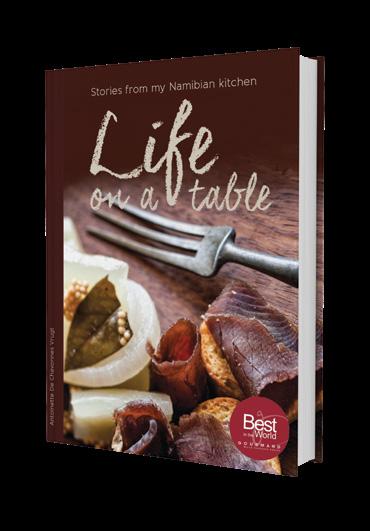
1 whole cauliflower
3 onions
5 ml garlic
5 ml ginger
3 tomatoes, puréed
2.5 ml peri-peri
5 ml garam masala
5 ml coriander
2.5 ml turmeric
Cashew paste (45 ml nuts and 45 ml water liquidised)
5 ml cumin powder
30 ml oil
45 ml butter
250 ml fresh cream
(or ½ yoghurt)
5 ml sugar
Salt to taste
• Clean the cauliflower and boil whole in salted water until half-cooked.
• Drain the water and allow to cool.
• Grind the onion, garlic and ginger to a fine paste.
• Heat the oil and butter in a pan, add the paste and sauté until golden brown and dry.
• Add the tomato purée and keep stirring until the mixture is dry.
• Add the cashew paste and sauté until the fat separates from the masala.
• Add the rest of the dry ingredients, including the salt and sugar, and stir for another 5 minutes.
• Add the cream and bring to the boil. The sauce should have a thick consistency.
• Pour the sauce over the cauliflower and bake in a preheated oven at 180°C for 30 minutes. Garnish with chopped coriander and serve hot.
Discover more of Antoinette's delicious recipes in Life on a Table
To order your copy contact Bonn Nortjé at Venture Publications: bonn@venture.com.na


Namibia, a country blessed with abundant sunlight and favourable wind conditions, holds significant potential for renewable energy development. The country’s location, coupled with its natural resources, presents an excellent opportunity to harness solar and wind power. This article explores the current renewable energy landscape, including load factors, regulatory environment, transmission infrastructure, and the challenges associated with intermittency and baseload supply.
Load factor, a critical measure in the energy sector, indicates the efficiency and reliability of a power source. For solar energy in Namibia, the load factor is exceptionally high when compared to most geographies due to the country’s location in Southern Africa. With over 300 days of sunshine annually, Namibia experiences an average solar load factor of around 20-35%. This is significantly higher than many other regions globally, making solar power a comparatively competitive option.
Wind energy also presents a promising opportunity. Coastal areas, particularly around Lüderitz, experience strong and consistent winds. The load factor for wind energy in these regions reaches above 50%, reflecting the potential for substantial energy generation from wind farms.
On the regulatory side, Namibia’s regulatory environment is progressively evolving to support renewable energy production and even export. The Namibian Electricity Control Board (ECB) oversees the regulation of electricity generation, transmission and distribution. The nation’s commitment to green energy is evident through initiatives like the National Renewable Energy Policy, which aims to promote renewable energy investments and infrastructure.
The introduction of the Modified Single Buyer (MSB) model has significantly transformed the regulatory landscape. This model allows Independent Power Producers (IPPs) to sell electricity across the national distribution and transmission networks to local customers and to export customers. Additionally, Namibia is part of the Southern
African Power Pool (SAPP), which enables power trading with neighbouring countries. This regional cooperation framework is crucial in unlocking the potential for exporting excess renewable energy to countries facing power deficits.
A robust transmission infrastructure is essential for effective energy distribution, both within Namibia and for export purposes. It must, however, be noted that Namibia imports between 60-70% of its electricity from neighbouring countries, which means that most of the electricity bound for export could simply displace imports. NamPower has laid out ambitious plans to enhance and expand the country’s transmission network. Over the next three years, NamPower aims to invest approximately N$14 billion in new power plants and transmission lines.
Some projects include the development of the transmission systems in Kunene and Erongo, which are crucial for integrating renewable energy sources into the national grid. Additionally, NamPower is exploring advanced technologies such as high-voltage direct current systems. These systems are designed to efficiently transmit electricity over long distances, making them ideal for exporting power to neighbouring countries.
Despite these advancements, challenges remain. The current transmission infrastructure requires significant upgrades to handle the increased load from renewable energy sources. Moreover, the geographic vastness of Namibia means that rural and remote areas often lack access to the national grid. Addressing these challenges is vital to ensure equitable access of electricity across the country.
The intermittency of renewable energy sources like solar and wind poses a challenge to maintaining a stable energy supply. Solar power generation is subject to daily and seasonal variations, while wind power can be unpredictable. This intermittency can strain the baseload supply, which is the continuous and reliable power needed to meet minimum demand.
Namibia’s current energy mix is heavily reliant on hydropower, supplemented by the above-mentioned imports from neighbouring countries. The Ruacana Hydroelectric Power Station, with a capacity of 347 MW, is the primary source of domestic electricity. However, hydropower is also subject to seasonal variability, particularly during drought periods.
To mitigate the impact of renewable energy intermittency, Namibia can explore several strategies. One approach is to diversify the energy mix by incorporating more dispatchable sources of power, such as biomass and gas-to-power projects. Biomass energy, derived from encroacher bush,
offers a sustainable and dispatchable power source that can complement intermittent renewables.
NamPower recognises the need for a balanced mix of renewable energy, baseload generation and, potentially, energy storage solutions to ensure grid stability. Developing storage systems, such as batteries, could be explored to store excess energy generated during peak production times. This stored energy could then be used during periods of low generation, helping to stabilise the grid. Investing in such technologies will be crucial as Namibia continues to expand its renewable energy capacity.
Namibia has immense potential for solar and other renewable energy generation, but realising this potential requires strategic planning and investment. Strengthening regulatory frameworks is crucial to attract more IPPs and private investments. This can be achieved by streamlining approval processes and providing clear guidelines for renewable energy projects. Additionally, investing in transmission infrastructure is essential to support the integration of renewable energy sources. This includes ensuring that rural and remote areas are connected to the national grid, promoting equitable access to electricity.
Enhancing regional cooperation is another key step. Namibia can leverage its participation in the SAPP to facilitate the export of renewable energy and strengthen bilateral agreements with neighbouring countries to create a stable market for surplus power. Promoting research and development is also vital to explore innovative solutions for energy storage and grid management. Encouraging partnerships with international organisations and research institutions can help Namibia stay at the forefront of renewable energy technologies. Lastly, increasing public awareness and education about the benefits of renewable energy and engaging communities in the planning and implementation of projects will ensure local support and participation.
Namibia stands at the cusp of a renewable energy revolution. With its abundant solar and wind resources, the country has the potential to become a leader in renewable energy production and export in Southern Africa. By addressing regulatory, infrastructural and intermittency challenges, Namibia can harness its renewable energy potential to achieve energy security, economic growth and environmental sustainability. The journey towards a greener future requires collaborative efforts from the government, private sector and communities to unlock the full potential of Namibia’s renewable energy resources.
Zane Feris Research Analyst


























IJG believes in tailoring their services to a client’s personal and business needs. For more information, visit www.ijg.net


10 minutes with local tastemakers


Little Miss Sunshine sums up Odile Gertze best. She is a lively voice on the 96.7FM airwaves, an emotive actress in multiple Namibian films, held the national pageant title in 2010, a phenomenal ballroom and modern dancer, and occasionally acts a fool in the good name of karaoke. All of that for a self-proclaimed introvert is no small feat!
To top it all off, she is the brand ambassador for the country’s largest tourism conglomerate, frequently jetting about Namibia. “(Travel) is like a tonic for breaking out of my shell,” says Odile, who undoubtedly has the country under her spell through sharing authentic and enticing stuff with her 11K-strong following.
From an early age the allure of travel and the transformative experiences it offers enticed Odile. “With my mother's career as an air hostess spanning 17 years, I found myself jet-setting across South Africa and Europe from as early as age 5,” she recalls of her upbringing. Not only did these formative years expose her to diverse people and places, but they taught her plenty about her place in this world, and in Namibia in particular.
It is always worth investigating why locals like Odile, with star potential and loads of talent, choose to invest it back into their motherland. She says: “Namibia's remarkable diversity thrives on ample space for growth, a haven for unique, youthful innovation, and a sense of belonging for every Namibian. Despite our challenges, our boundless passion can propel us toward realising our dreams. We just need to work hard.” Through playing real Namibian characters on stage and film, speaking about our collective

FNB Senior Lifestyle Account holders can now enjoy more savings:
What’s new:
• No monthly account fee charged
• No minimum balance requirement
• 15 free transactions per month, including swipes, payments and 2 branch withdrawals
Other benefits include:
• Free funeral cover of N$2,500
• Free debit order switching
• Free subscription to FNB Online Banking, Cellphone Banking and FNB App
• Free inContact Messaging service
• Access to Lending, Investment, Fiduciary and Insurance products and services
Namibia's remarkable diversity thrives on ample space for growth, a haven for unique, youthful innovation, and a sense of belonging for every Namibian.
culture and lifestyle on-air and broadcasting the many special places to see and experience in Namibia, Odile is a tastemaker in the truest sense of the word. Her positive disposition and creative lens leave an imprint on everyone in her wake.
For Odile, a life and career filled with variety is the only option. “Predictability isn’t my thing,” she says, admitting that the only constant in her routine is mornings spent journaling, exercising, meditating, and soaking up some sun. She also finds solace and spice in life while spending time with loved ones. In fact, this author recalls a Friday afternoon driving by Roberto’s Pizza in Eros, where Odile was sitting next to her nephew, spending quality time over a pizza for two.
“When you immerse yourself in activities and a career that truly resonates with your interests, it can bring profound satisfaction and purpose to your life,” says Odile, while also acknowledging that her days are filled with the admin that comes from being a Jane of all trades.
Choosing to share wholesome, authentic perspectives of her life as an actress, host and brand ambassador, Odile’s Instagram feed is a joyous mix of content about travelling, self-care and spa days, family time and an obscene number of positive quotes. She’s bent on contributing positively to the social media landscape saying “I firmly believe in the power of authenticity and personally would prefer to resist the temptation to conform to idealised social media standards. My aim is to curate content that inspires genuine connections and motivates others to be their true selves.” Tagging along with Odile, albeit virtually, will most certainly add positivity to your day.
Part and parcel of Odile’s genuineness is the fact that she can look back and laugh at her oopsies, cringe at herself for mispronouncing 'debris' on live radio and falling on stage, and give herself the grace to make earnest mistakes. It’s a whole different ball game to slip up in the public eye, which Odile will admit is one of the biggest challenges she’s had to overcome. The key is not to take
things too personally, something we can all take away from our own fumbles and mishaps.
The starlet says: “Being human means having the opportunity to grow, expand, and challenge yourself, paving the way for personal growth and fulfilment. And thanks to my incredible mother, who is continuing her studies while in her 50s, I have learnt that while the world is telling you who to be, what matters is what you tell yourself. Keep following those dreams.”
Charene Labuschagne


Join us for a morning of padel and fun - all for a good cause!
FlyNamibia is excited to host our first corporate padel charity day in partnership with Namibia Padel. Book teams to take part and join us for a fun-filled morning as we raise funds for SPES Charity.

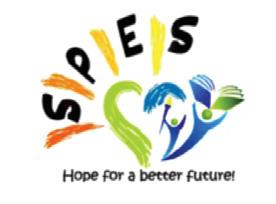

30 August 2024
8:00-13:00 (followed by a lunch braai)
Cost per two-man team: N$ 3,000
All funds raised will go to SPES - STEP OUT OF POVERTY THROUGH EDUCATION, ENCOURAGEMENT AND SUPPORT
Dress-up Theme: “When I grow up…” (think your Dream Job as a kid)
Prizes to be won for winning teams, best dressed, most enthusiastic and more!
To enter visit: www.flynam.com/purpose
Companies or individuals are invited to enter teams (2 people in a team) that will take part in a round-robin day of padel matches. Anyone is welcome, even if you have no padel experience. with

Three women from different centuries are united by their hidden strengths and connection to the natural world. In 2019, Kate escapes her abusive partner and retreats to Weyward Cottage, a mysterious inheritance from her great aunt and uncovers the cottage's secrets. In 1619 Altha faces trial for witchcraft, her knowledge of nature branded as dangerous magic. As World War II rages in 1942, Violet yearns for freedom and education, bound by societal norms and haunted by her mother's mysterious past. This spellbinding novel weaves their stories together, celebrating female resilience and the enduring power of nature.
Goodreads score: 4.08/5

Natalie started her YouTube channel about eight years ago, initially trailing a stereotypical youtuber format. Through her first series titled 800 Miles, Natalie quickly found her unique style of videography on a weeklong road trip through parts of the USA. Two years ago she bought, renovated, lived and travelled in a van, the process of which was documented in her most recent series titled Borderless In this 8 part production, her nostalgic, Wes Anderson influenced filmmaking style truly comes to life, and is a viewing pleasure for any cinephiles. While her channel has come to a standstill, with Borderless being her last body of work, subscribing will do no harm, as whatever she has up her sleeve next is sure to impress.

The Dallas Cowboys NFL team are regarded as America’s football team. Their cheerleaders, who have been around since the 70’s, are regarded as America’s sweethearts. The Dallas Cowboys Cheerleaders (DCC) has become arguably the most highly coveted cheer squad on the planet, with thousands of young, hopeful women auditioning every year for one of 36 spots. This docu-series takes an in-depth look at the 2023 auditions, training camp, and football season. Following the organisers, veterans and rookie dancers through gruelling preparation and heartbreaking cuts, the series highlights one of USA’s most lucrative sports businesses and also shows the dark underbelly of what it truly means to be America’s Sweethearts.
Tomatometer: 100%
Our monthly round-up of good books, podcasts, channels, movies and series.

Embarking on a three-year journey across the US and the UK, journalist Hayley Campbell delvies into the world of the death industry. Inspired by her childhood fascination with death, Campbell meets a variety of professionals including embalmers, funeral directors, crime scene cleaners, and even a former executioner. Through her compassionate and probing interviews, she explores why these individuals choose to work so closely with death and how it shapes their perspectives on life. This captivating book blends reportage with memoir, history, and philosophy, offering a profound look at Western attitudes toward death and the people who confront it daily.
Goodreads score: 4.25/5

Huberman Lab
This health and science podcast is hosted by Andrew Huberman, an American neuroscientist and associate professor of neurobiology and ophthalmology at the Stanford University School of Medicine. His laboratory's recent studies focuses on the influence of vision and respiration on brain states like fear and high attention focus, and developing rapid and effective tools for mitigating stress and improving sleep. Covering a diverse range of topics from mental health and fertility to ADHD and meditation, Huberman and his podcast guests - predominantly doctors - give professional yet comprehensible insight.

Gary Johnson (Glen Powell) is a prim and proper professor by day, but moonlights as a fake hit man for the New Orleans Police Department. He has a knack for slipping into various personas to catch would-be criminals in the act of hiring a hitman, changing up his characters to meet client expectations of what a hitman should be. Under the guise of slick and cool Ron, Gary meets Madison (Adria Arjona), a beautiful young woman seeking to oust her troublesome husband. Romance ensues, and so does deception, drama and ever-escalating stakes.
Tomatometer: 95%






























Botswana’s president’s official visit to Namibia provided an opportunity to deepen existing cooperation and explore new avenues for collaboration. His Excellency Mokgweetsi Masisi, the president of the Republic of Botswana, was the keynote speaker at the official opening of the 2024 Swakopmund International Trade Expo (SWAiTEX) which took place at the Vineta Sports Stadium in Swakopmund. His visit included official talks with His Excellency President Nangolo Mbumba.
Describing the bond between Botswana and Namibia as a “special relationship”, Masisi said it stems from profound values, traditions and historic ties which both countries cherish and uphold.
“It is only fitting that this robust neighbourly collaboration be supported by bilateral agreements spanning multiple sectors such as agriculture, water, defence and security, as well as transportation and logistics,” said Masisi.
The Botswana president strongly believes that the dry port facility at Walvis Bay, together with the recently signed agreement allowing citizens from both countries to travel between the nations using only national identity cards, which aligns with the Southern African Development Community’s (SADC) Protocol on Facilitation of Movement of Persons, hold significant potential for deepening bilateral cooperation. He noted, however, that the two countries are yet to fully tap into bilateral economic prospects.
“In 2023 Botswana exported goods worth US$60.9 million to Namibia. Diamond exports constituted 48% of this total, with coal and electrical cables making up 10% and 5% respectively. Additional notable exports from Botswana to Namibia encompass passenger vehicles and fibre-optic cables,” the president said.
Areas for further collaboration
With Namibia procuring livestock vaccines from the Botswana Vaccine Institute (BVI), Masisi said it offers an opportunity for the two countries to conduct coordinated foot and mouth disease (FMD) vaccination campaigns and to ensure the surveillance of FMD.
“Both countries share common strengths in areas such as animal disease control protocols, range management practices, abattoir and meat hygiene practices, and wildlife conservation strategies,” said Masisi. He further stressed the importance of the current distinctive provision of tourism experiences offered by the nations, suggesting joint marketing efforts to extract more value from tourism endeavours.
The Botswana president also expressed interest in the energy sector, where Botswana Oil Limited (BOL) already initiated discussions with the National Petroleum Corporation of Namibia (NAMCOR) to explore possibilities for cooperation in establishing shared fuel storage facilities at Walvis Bay in the Erongo Region, which include joint efforts for fuel transportation and coordinated approaches towards sourcing oil from Angola.
Welcoming Masisi’s contributions, President Nangolo Mbumba shared the two countries’ long-standing history, calling for continued dialogue to enhance the effectiveness of policies in developing both nations and improving the living conditions of the people. Mbumba said, “In the area of cross-border trade we continue to make progress. Our government donated a piece of land at the Port of Walvis Bay to Botswana to construct a dry port and make Botswana sea linked. This was done not only as a gesture of goodwill, but to facilitate imports and exports of goods and services.”
On border security, Mbumba stressed the importance of promoting peaceful co-existence and good neighbourliness along the common border. “Our cooperation in defence and security matters is crucial for addressing transnational threats such as terrorism, organised crime and illicit trafficking. By enhancing our security cooperation, we can better protect our citizens and contribute to a safer and more stable southern Africa," said Mbumba. Looking forward to building on the progress achieved, Mbumba reassured that Namibia remains a steadfast friend and partner of Botswana and looks forward to continued dialogue and collaboration to achieve common goals.
Maggie Forcelledo Paz




AIMS TO SHARE THE WONDER OF SCIENCE WITH EVERYONE, OFFERING A UNIQUE HANDS-ON EXPERIENCE FOR STUDENTS AND TEACHERS. IT SETS ITSELF APART BY EMPOWERING STUDENTS TO BECOME THE SCIENTISTS IN THE PROGRAM. LSOP IS OPEN TO ALL, PROVING THAT ANYONE, REGARDLESS OF AGE, CAN GRASP THE MAGIC OF SCIENCE.
“Unlocking science for all ages at LSOP - Where belief meets achievement!”

The Little Shop of Physics (LSOP) program is a collaboration between the Colorado State University and B2Gold Namibia. The program commenced in 2016 as part of B2Gold Namibia’s Corporate Social Investment Education projects. It aims to assist Namibian science teachers in bridging the gap between theory and practical understanding of physics. LSOP's approach to teaching and learning is based on Student-Centred Education (LCE). The program seeks to find creative ways to share the wonders of science with pupils and learners of all ages, backgrounds, and interests. The programme present a unique hands-on science experience to a diverse range of students and teachers.
While LSOP at the Otjikoto Nature Reserve has attracted numerous beneficiaries, it became apparent that not everyone had the means to travel to Otjikoto. B2Gold introduced a mobile unit (serving as a lab-onwheels) taking LSOP to the communities. From 2022 to 2024, the LSOP van visited schools in the Hardap, Otjozondjupa, and Kunene Regions. Exposing pupils to LSOP activities and contributing to improved endof-year marks in several schools.
The program outcomes include training 30 science teachers from 8 high schools in integrated physics practical activities, directly supporting 300 grades 10, 11 & 12 students from 10 schools in physics lessons presentations, and indirectly supporting 1,500 pupils from grades 8 to 12 through their teachers, resulting in improved understanding of physics concepts and pass rates.

LSOP AT OTJIKOTO
Over the past 6 years, LSOP has made significant strides Strikes Nationally. The LSOP Teachers’ Training Program has successfully trained 730 physical science teachers from 8 regions of Namibia. Additionally, over 5,000 pupils have visited the LSOP Centre at Otjikoto Nature Reserve.


The Little Shop of Physics (LSOP) hub represents a significant collaboration between the One Economy Foundation and B2Gold Namibia, aimed at enhancing STEM education in Namibia with a special focus on physics. This initiative transcends traditional educational boundaries, offering innovative opportunities for young Namibians to explore and unlock their potential in the field of physics. Serving as a dynamic hub for exploration, experimentation, and discovery. The LSOP hub emphasizes hands-on learning and interactive experiences. The #BeFree Youth Campus, known for its multi-faceted and integrated approach, collaborates closely with the LSOP to enhance the overall educational experience. The STEM center at the campus, along with its various activities, integrates LSOP’s findings into a broader learning context that includes radio and podcasting, STEM projects, library resources, and health services. This interdisciplinary integration ensures that learning is holistic and impactful.












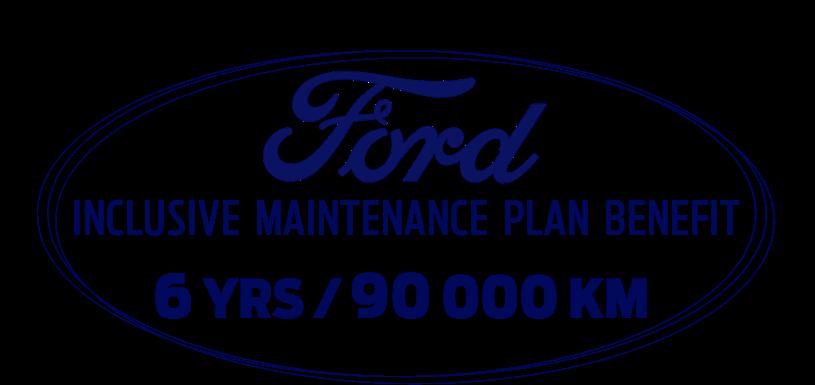





Hilaria Graig has made her life about people. Born in the 80’s in that 15th Region of Namibia; Exile, she has learned to adapt and adapt again in each new place, always watching and learning from the people around her.
From her birthplace Havana, Cuba, she moved to Angola then Zambia before returning home to Namibia in 1989. She attended several different schools including the People’s Primary School, Emma Hoogenhout Primary, Delta and Karibib Private School, saying; “My formative years were all over the place.” The constantly changing environment led her to rely heavily on her large family and the faith she was raised in. Even now, she finds her motivation is still rooted in family.
“I consider myself a family person,” she told 99FM Breakfast Show Host, Mooki "Mooks" Mootseng. Some of her most potent influences include her “strong and courageous paternal grandmother,” and her aunts and uncles. However, her biggest hero and influence is her father. “Not only has he consciously moulded me into the person that I am today, but my father has never negated his fatherly duties and responsibilities. And, he continues to guide and support me even in my adult years.” His work ethic and discipline have formed her perspective on fulfilment and success.
Success, however, changes during the different stages of one’s life. Right now as a parent, success for Hilaria is ”having happy, healthy, well-rounded human beings that I am raising together with my husband.” However, career and family are inextricably linked and the plates must keep spinning; “When you start having children and your career is also taking off, those things kind of happen at the same time. What is most important is to remember that
when I’m at work, I’m at work… Whatever I put my name on needs to be the absolute best. And so I do the same for when I am at home.”
Hilaria’s career as a specialist in Communications and Marketing shows her commitment to the good of the Namibian people. Her career spans various sectors including central banking, local government, public enterprise, and the insurance industry. "I live by the principle of always being hungry to learn,” she told Mooks of her strategy in the office, “when you think you know it all, there's no room for improvement.” Her current role as the Manager: Corporate Communication and Stakeholder Relations for the MVA Fund is a continuation of this people-oriented perspective. “If you’re not learning, you’re not growing, if you’re not growing, you’re not living… What’s worse than being alive but being dead?"

No matter what she has faced, Hilaria maintains a “glass half full” perspective. She can always find a way to put a positive spin on things. “I always try to make the best of every situation, I learn from it and keep it moving, so to speak.” How does she do it? By “watching and learning” from those around her. There is something you can learn from every person you meet.
Proudly Sponsored by



Namibia and Botswana are set to enhance regional trade with the launch of a OneStop Border Post at Trans-Kalahari/Mamuno Border Post in August 2024.
Advantages of a One-Stop Border Post:
Faster clearance times
Improved traveller experience
Increased efficiency
Improved Security and Compliance
Reduced Cost




Over the years, I have been very fortunate to have travelled the country quite extensively and was lucky enough to get to do so again recently. The thing I enjoyed even more than seeing lodges filling up with tourists again after the COVID years, was a local Namibian tour guide hosting and speaking to visiting tourists in a foreign language. I don’t just mean German because, in a way, that can be downplayed as an easy language to pick up in Namibia (though I’ll admit it is still one that I am less than comfortable speaking). Rather, it is when I hear them speaking French or Italian, or some other international language, that I get a real thrill because it just proves that, given the right opportunities, there is nothing that is out of reach for Namibians.
It always gets me thinking once again about the “lottery of birth” – the fact that certain opportunities are either given to, or withheld from, a person simply due to where, when and to whom they are born.
It is easy to say that certain people are geniuses, visionaries, or that they got where they did because of hard work, and I am not necessarily saying that it is not the case. Without a doubt, Jeff Bezos was a visionary when he came up with the idea to start selling books online and founded Amazon, but he was also supremely fortunate to have been born in the United States of America to parents who were wealthy enough to loan him the $250,000 he needed, despite him having told them that there was about a 70% chance they would lose all of it. I imagine it would have been a lot harder for him if he had been born to a single mother who cleans houses for a living in Windhoek.
There are of course cases where people succeed and do great things despite their circumstances. Charles Dickens famously had to leave school at the age of 12 to work in a boot-blacking factory after his father was sent to debtors’ prison, but even he can be thought of as fortunate to have been born in England – then the major economic and political power of the world – at a time when literature was more accessible than ever due to various journals publishing stories in a weekly or monthly serial format that made literature more affordable to all sectors of society.
This is not to take anything away from genius where it exists but, as American palaeontologist, evolutionary biologist and historian of science, Stephen Jay Gould is quoted as saying: “I am, somehow, less interested in the weight and convolutions of Einstein’s brain than in the near certainty that people of equal talent have lived and died in cotton fields and sweatshops.”
The danger of ignoring the “lottery of birth” concept is that it can lead to the idea of exceptionalism, where people begin to believe there is something innately special about them, or that they got where they are through sheer hard work and determination, and that the only reason other people have not achieved what they have is because they are lazy, or do not want it badly enough. Sure, some of the richest or most “successful” people on the planet probably do work hard, but so do people at the till at your local supermarket or mopping the floors at the local mall. There are other factors that got the “rich and powerful” to where they are, and a little humility would not go amiss. Even Warren Buffett, considered by many to be the most successful investor of all time (and as I write this the tenth richest person on the planet), is humble enough to say: “No great credit to me. I was just lucky at birth… I shouldn’t delude myself into thinking I’m some superior individual because of that.”
Getting back to the linguistically skilled tour guide who started this train of thought, and the idea that there is nothing that Namibians cannot do: beyond merely acknowledging the lottery of birth, what also gets me wondering is how much more those affected by it would have been able to achieve had they been afforded the same opportunities as others?
How different would Namibia, Africa, and the entire world look if those many hundreds of years ago we would have been able to encounter people we had never met before with respect and treated them fairly and equally?
But perhaps that is a topic for another column…
Until next month, enjoy your journey.
David Bishop







Pfohls Men’s Outfitters, a Windhoek-based high-end fashion store trading since 1951, has undergone a lavish transformation. The recently unveiled space now features a female section, a stunning bridal boutique and a lounge fit for the ever-so-stylish bride.
For fashion lovers, walking into the modernised version of the legacy store can be likened to a six-year-old experiencing a candy shop for the first time. With racks and shelves showcasing designer garments for men and women, it’s a shopper’s paradise. The male section remains fully stocked with tailored shirts, pants, suits and accessories for any occasion, while the new female section is equally impressive. Think day dresses, evening gowns, casual and corporate wear… you’ll find it all at Pfohls.
Another feature of the revamped store is an extensive collection of new and previously owned luxury brands such as Versace, Dolce & Gabbana, Christian Dior, Hermès and many other renowned designer brands. This additional offering caters to those who love the finer things in life, whether they have deep pockets or not. Seemingly reading my mind as my eyebrows lift with the mention of six-figure price tags, co-owner Cobus Möller assures me that shoppers have the option of a 3-month lay-bye to purchase without breaking the bank.
The store design is another feature to marvel at. The aesthetic decor in all sections is mesmerising, and the floorlength mirrors and lush seating ensure shopping here will be a pleasant experience. On a tour of the revamped store, the owners proudly show off bespoke decor and hand-crafted finishings that make it hard to believe it took only eight weeks to complete the store renovations. Dressing rooms are plenty, and the staff are on hand to give personalised service to each shopper.
Power partnership
The new and improved Pfohls is the culmination of a vision by co-owners Cobus Möller (head designer) and Natalia Zvonareva (creative director) for Windhoek to have its first world-class fashion department store. Cobus is a seasoned Namibian designer who built a name for himself as a couture designer. Natalia is an interior designer and fashion collector who loves sourcing rare fashion finds.
Tailored to perfection
Pfohls has a long-standing history of offering tailoring assistance to its shoppers. As part of the new offering, women and brides-to-be also receive free tailoring services for every garment they purchase. Head designer Cobus graduated with top honours from Melbourne School of Fashion, where he polished his skills in design, advanced pattern making and production through contrasting areas
in tailoring, leather wear and bridal gowns. Today, Cobus has found a home at Pfohls, where his creativity runs free as a bridal designer. He is also on hand for customers who need any alterations on garments bought in the store, lending his impeccable skills and eye for design to ensure that every customer leaves happy.
For in-store styling, co-owner and creative director Natalia is your go-to girl. Her years of experience as an interior designer and shopping at the most exclusive shopping destinations have taught her invaluable styling lessons and the value of luxury customer support. Her eye for designer brands also comes in handy when sourcing brands from retailers, especially from individuals. She explains, “Sourcing original brands is a two-way street for us. We get people who WhatsApp us, claiming to have original brands to sell to us. When we get to inspect the items, they sometimes turn out to be fake or dupes. On the other hand, customers need to trust that we are selling authentic brands, and I can assure you that we do. We have a very intense authentication process and research to ensure we only stock original brands.”
The future of Namibian luxury shopping
Looking to the future, Cobus and Natalia envision Pfohls becoming one of the leading shopping destinations for Southern Africans. “This is the first Namibian department store for luxury brands, selling new, second-hand and consignment pieces,” says Cobus. When I ask if we would find Namibian brands in the store, he confirms it without hesitation. The vision, he says, is to accommodate Namibian brands alongside international ones, as long as they are of high quality.
For exclusivity, only one design per item is stocked at any time, and bridal customers are assisted by appointment only. “Bridal fashion and tailoring is very time-consuming, so we only do it by appointment,” explains Cobus. For the stylish bride who dreams of making their big day special with a Pfohls dress, this dream can come true for as little as N$2,000, and for those who are not scared to splash out for the special occasion, prices go up to N$150,000 per dress.
So whether you are a Namibian who loves premium fashion or a style-conscious tourist, your time at Pfohls will make you feel like you have walked into Harrods or Bergdorf Goodman. And if that is the case, Cobus and Natalia have achieved their dream of positioning the store as Namibia’s premium department store.
Follow Pfohls on Instagram @pfohlsfashion and visit them on 29 Independence Avenue, Windhoek.
Rukee Kaakunga



He is youthful and driven by a profound passion.
In his own words, Leroy describes himself as a 'town boy that de-urbanised.' He stands at the helm of Miombo Forestry Products, a Namibian enterprise dedicated to timber processing and carpentry, with a vision to redefine the narrative surrounding timber harvesting in the region. He firmly believes that poverty, rather than timber harvesting, is the cause of deforestation.
Conversing with Leroy reveals a person deeply rooted in his convictions, much like the towering trees of the forest. His commitment lies not only in fostering growth within others but also in safeguarding our precious natural heritage.
Leroy Diocotlhe was born and raised at Döbra, just 25 kilometres outside of Windhoek. Schooled in the capital city and having studied information technology and software development, Leroy decided to take a completely new direction in life after reading the government policy around Vision 2030 and realising the level at which our natural resources are being exploited. In a profound moment of anger about the situation, Leroy decided to focus on a career that would support natural resource management.
“No one was doing anything significant with our hardwoods, except for local crafters. A lot wasn’t controlled back then,
the act had loopholes and without timber being processed here, and no one having the machinery or experience to do so, exploitation was rife.”
Miombo Forestry Products was named after the Miombo Woodlands, a shared transnational forest ecosystem covering 2.7 million square kilometres across eight Southern African countries. These woodlands are considered one of the biggest and most important ecosystems in the world, sustaining more than 100 million rural and 50 million urban Africans.
Despite being the first company in Namibia to receive an environmental clearance certificate to process timber, Miombo Forestry Products had to deal with many rejections before the company took off. Leroy explains, “At the time, the timber industry was perceived to be an unbankable endeavour, made worse by the rampant illegal harvesting of our timber resources. But I am proud to say that we have emerged as pioneers in the industry.”
Looking back on his journey, Leroy says, “I’ve grown in leaps and bounds from when I first started, and so has the industry. There’s been a lot of awareness created, from the Ministry to NGOs and various stakeholders. Today, I’m creating school furniture for the Ministry of Education.” A remarkable feat considering that in the past, Namibia’s school furniture needed to be imported.
Leroy explains that 90% of the wood he uses is sourced from Angola. “Only 10% of our landmass is woody. This is why I have collaborated with Angolans and Zambians to source wood that is local to the region and reduce the carbon footprint.”
Leroy emphasises the significance of local wood harvesting in Namibia, despite relatively low levels of timber extraction. He points out that a major driver of deforestation in the country stems from the lack of access to basic amenities like water and electricity in rural areas. In response, Miombo Forestry Products has launched an initiative dubbed “Timber to Water”. Under this programme, they compensate local communities who own the resources by providing them with water. By monetising wood sustainably, the initiative aims to discourage communities from resorting to indiscriminate tree felling, thereby fostering environmental conservation and community empowerment simultaneously.
Another interesting aspect of Leroy’s timber harvesting is that, in Namibia, he does not chop down trees; he thins or prunes them. He explains that this is a sustainable use practice that helps the forest to thrive. “Thinning and pruning can be healthy for a forest to regenerate. There is competition in the bush – big trees don’t allow the smaller trees to grow. I’ve seen that when you thin the big tree, you allow the smaller ones to increase in size.”
Leroy shares the process for timber harvesting in Namibia: “The harvesting is done selectively. It is not like the tree felling you see in plantation timbers, where all the trees are just cut down. If we go through an area where we’ve been harvesting, you won’t even notice that we were there.
We only harvest species that regenerate, and obviously it’s important how you do the harvesting.”
Leroy works closely with the Ministry of Environment, Forestry and Tourism. He explains that they do inventories of the trees and decide which trees can be cut. “When we harvest a tree for its timber value, we do not uproot or kill the tree. Its root systems are left intact to allow it to regrow. In the past, unprocessed wood was taken out of the country, but now that we process locally we add more value, use less and waste less.”
Leroy’s timber processing plant is found in the tiny border town of Katwitwi in the Kavango West Region. “It is important for our country that we don’t have all the skills in urban areas only. I want to inspire other Namibians to join me in de-urbanising. But first, the community needs skills and opportunities in their regions. Currently there are many issues in the rural areas, broken homes and this is mostly because of poverty.”
Starting small, this business has grown from a raw material supplier to include a carpentry aspect. “I did that to be able to create capacity. I’ve since added my own machines, and you’ll find them in a very rural part of Namibia where the classroom is still found under a tree. Hopefully soon I’ll be able to make donations to that school and see the whole area grow.”
Dreaming big, Leroy hopes to offer an apprenticeship programme to train young people from his region. He is partnering with the National Training Authority to be able to do this. Growing his career in a field that was once dominated by negativity, was inspired. Today, there are great strides being made in the forestry sector in Namibia and the sustainable use of a resource, when done correctly, is a fundamental element in the conservation of that resource. Leroy adds that many stakeholders, such as the Hanns Seidel Foundation, are doing great work in creating dialogues around the country that have really opened people’s eyes.
Leroy’s ultimate aspirations revolve around contributing to a flourishing Namibian timber industry that not only generates sustainable employment but also ensures long-term benefits for communities entrusted with managing this vital natural resource. He envisions making a tangible impact and is driven by the goal of fostering the growth of an industry that prioritises sustainability. Leroy’s overarching objective is to advocate for a robust legislative and regulatory framework that supports the development of a sustainable forestry and timber sector in Namibia.
This young man is showcasing how the importance of preserving our natural resources for future generations can present business opportunities. Through his endeavours with Miombo Forestry Products, Leroy exemplifies the potential for individuals to effect positive change by aligning their passions with the greater good.
Kirsty Watermeyer
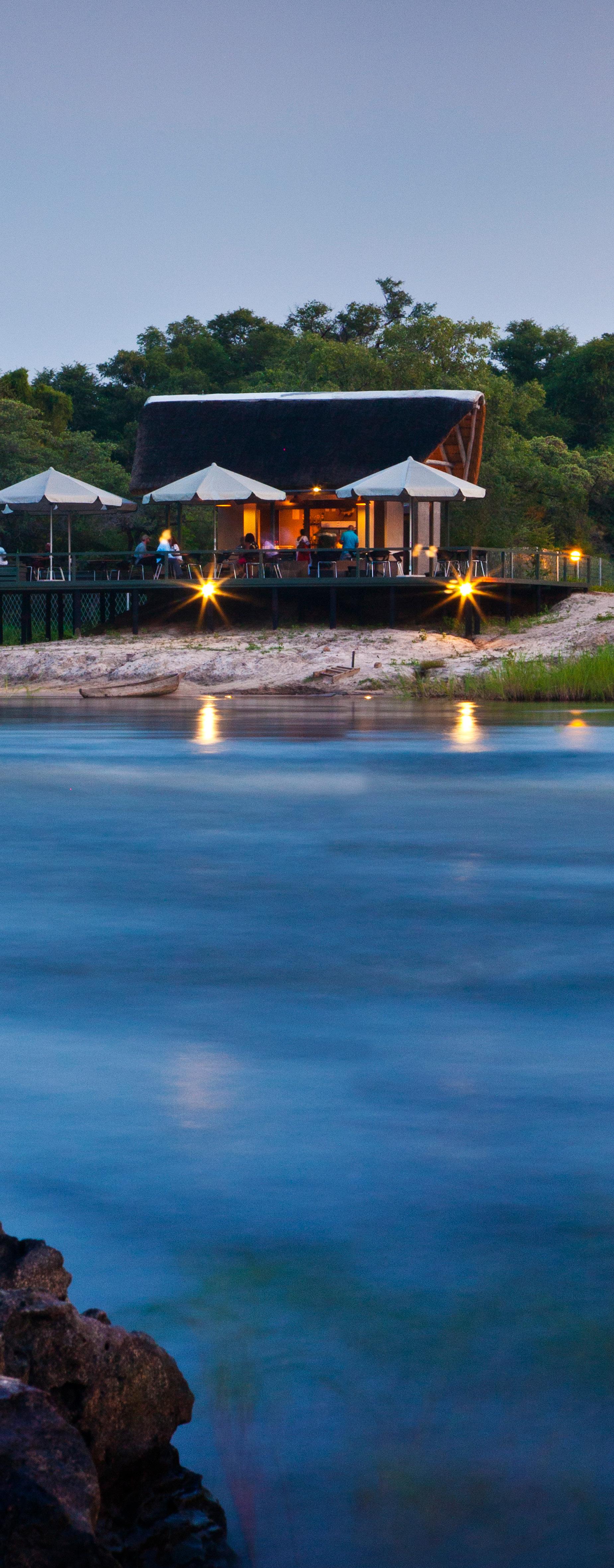

your conference
Discover unparalleled conference facilities amidst breathtaking natural landscapes with Namibia Wildlife Resorts. Host your next event at Popa Falls Resort, where the serene Okavango River meets nature’s tranquility.


Elevate your business travel with the NWR NAMLEISURE CORPORATE CARD!
Enjoy exclusive discounts on accommodation and activities, ranging from 50% for Namibian to 10% for international cardholders. With a validity of three years and easy renewal, it’s tailored for businesses with a minimum group size of 10. Experience convenience, savings, and unparalleled benefits for your corporate outings.
The lure of the area is its wild and untamed quality, which gives visitors a peek into authentic African lifestyles. Perennial rivers and expansive floodplains, lush sub-tropical vegetation, an abundance of game and birds, and scattered settlements are a complete change of scenery from the rest of the Namibian landscape. The 575-kilometre tarred Trans-Caprivi Highway provides easy access to the region.
The Okavango River and its broad floodplains make the Kavango East and Kavango West regions considerably greener than the rest of Namibia. The river forms a natural boundary between Namibia and Angola for more than 400 km and is the lifeline to the Kavango people, who make a living from fishing, tending cattle and cultivating sorghum, millet and maize.
The main town in the Kavango East Region is Rundu, situated on the banks of the Okavango River. This is the home of Namibia’s well-known Kavango woodcarvers. Their ancient craft, handed down over generations, is a flourishing industry today. Wood carvings are made and offered for sale at the Mbungura Woodcraft Cooperative, which has its main workshop and office in the town. Another worthwhile stop is the Rundu Open Market to taste some local fare and experience the unique culture of the region. FlyNamibia offers several flights a week to Rundu from Windhoek. Thirty kilometres east of Rundu is the Sambyu Museum, an art and crafts facility displaying woodcarvings and traditional crafts from the Kavango Region and southern Angola, and stone tools found locally.


FlyNamibia between Hosea Kutako International Airport and Victoria Valls, Maun and Katima Mulilo, as well as between Eros Airport in Windhoek and Ondangwa, Lüderitz and Oranjemund.
Rundu
Mangetti National Park

Previously managed as a game camp for breeding rare and endangered species such as black and white rhino, the Mangetti conservation area was proclaimed as the Mangetti National Park in 2008 to protect its wildlife and vegetation and provide tangible socioeconomic benefits to local communities through careful tourism development.
Situated some 100 km southwest of Rundu in the Kavango West Region, the park extends over 420 km² and is managed jointly by the Uukwangali Traditional Authority and the MEFT. Animals seen here include eland, blue wildebeest, African wild dog, leopard and hyaena. Additional species such as common impala, gemsbok, kudu, giraffe and Burchell’s zebra were translocated through the project Enhancing Wildlife-based Economy in Rural Areas from Etosha National Park and the private sector.
Find more Namibian travel inspiration at www.thisisnamibia.com
Follow @thisis_namibia on Facebook and Instagram for extraordinary Namibia travel stories.


Since ancient times, cosmology – the study of the universe as a whole – has piqued human curiosity. Its origins can be traced to early civilisations’ attempts to understand the grandeur of the cosmos. Ancient Greek thinkers such as Aristotle and Ptolemy proposed geocentric models where Earth lay at the centre of the universe, surrounded by celestial spheres carrying the stars and planets. Though these early hypotheses prepared the way for later astronomical theories, it was not until the advent of modern scientific research that cosmology started to take on its current form. Parallel to this, religious writings such as the Bible presented their own interpretations of creation, igniting discussions and debates that still affect contemporary philosophy and science. The Big Bang model is currently at the forefront of contemporary cosmological theory. It not only offers a rational account of the universe’s origins, but it also serves as the foundation for comprehending the evolution of the universe.
The Big Bang idea was first proposed in the early 20th century based on the research of scientists such as Georges Lemaître. It was then supported by data and observations that were accumulated over the course of the following decades. Though initially viewed with scepticism, the concept of a single event commemorating the universe’s creation gained momentum as observational astronomy progressed. According to the Big Bang theory, the universe started as an incredibly hot and dense singularity 13.8 billion years ago, from which all matter, energy, space and time swiftly expanded. The cosmos began to expand, and it eventually evolved into its current shape.
The discovery of the cosmic microwave background (CMB) radiation in the middle of the 20th century was one of the major advancements that supported the Big Bang theory. This radiation was thought to be remnant thermal radiation from the early universe, and it offered strong evidence for the Big Bang theory’s prediction of the universe’s initial hot and dense state. Additionally, the discovery of the redshift of galaxies provided more evidence in favour of the notion. The more space a galaxy had, the faster it was receding from us, according to astronomers’ observations. A hot, dense condition of the cosmos expanding is consistent with this observation, which is captured in Hubble’s Law.
Inflation theory extends the Big Bang model by proposing a period of extremely rapid expansion in the universe’s first fractions of a second. This rapid expansion resolves fundamental puzzles of the standard Big Bang model, such as the horizon and flatness problems. By stretching the universe exponentially, inflation ensures that regions now widely separated were once in proximity to reach thermal equilibrium, which explains the uniformity observed in
the CMB radiation. Additionally, inflation predicts a flat geometry for the universe, matching observations, and provides a mechanism for the origin of cosmic structure by amplifying quantum fluctuations into the seeds of galaxies and large-scale structures.
Cosmology also addresses the enigmatic dark matter and dark energy components of the universe. Dark matter does not directly emit light or energy that can be detected, but it interacts gravitationally with normal matter and is thought to make up around 27% of the universe’s mass-energy content. The gravitational pull it has on galaxies and galaxy clusters suggests its existence. Even more mysterious is dark energy. Its elusiveness makes it difficult for physicists to pinpoint its basic components, which are thought to be non-baryonic particles. By contrast, dark energy, which makes up approximately 68% of the universe, violates accepted theory by acting as a repulsive force that accelerates the expansion of the cosmos. As a result, galaxies are drifting away faster and faster over cosmic time. The exact nature of dark energy is still up for debate; hypotheses range from dynamic fields circulating throughout space to a cosmic constant. When combined, these enigmatic elements control the cosmic energy budget, influencing the universe’s large-scale structure and evolution.
The density of the cosmos and the behaviour of dark energy are two crucial aspects that determine its fate. If dark energy continues to dominate and speed up the expansion of the universe, it could lead to a “Big Freeze”, in which cosmic expansion proceeds unchecked. In this scenario, the universe would eventually cool down to almost absolute zero, becoming sparse and barren as galaxies drift further apart and stars burn out over enormous timeframes. As an alternative, dark energy might cause a “Big Crunch” or cyclic universe, in which the universe’s expansion stops and reverses, possibly resulting in the universe’s collapse and rebound. These disparate results highlight how dark energy has a significant influence on determining the fate of the universe.
With the help of cutting-edge physics experiments, theoretical modelling and observational astronomy, modern cosmology is still developing. The aim of projects like the James Webb Space Telescope, the Large Hadron Collider and the Sloan Digital Sky Survey is to uncover deeper facts about the origins, evolution and composition of the universe. In the end, cosmology holds a special place at the intersection of physics, astronomy and philosophy, offering a profound comprehension of the fundamental nature of life. As our comprehension of the cosmos expands, so does our admiration for its rich beauty and complexity.
Victoria Ndayambekwa Nakafingo

he juxtaposition between two artists sharing an exhibition may never have been greater than that of Jacqui van Vuuren and Chris Johnston. The ceramicist and photographer, long-time friends and both exhibiting for the first time since 2018, are set to present new work at BELLHAUS Atelier & Galerie from 18 July until 10 August 2024.
Striking an uncanny balance between the artists’ personalities and their contrasting mediums, DELICATE THORNS proposes two equally interesting outlooks on existence. Jacqui’s gentle,
feminine energy mirrors the delicate nature of her ceramics, while Chris’ unapologetic, practical nature is tangible like thorns through his photographs. In the exhibition, viewers can expect parallel cases made for the glass-half-full and glasshalf-empty perspectives, both valid in their own right in our day and age.
Inspired by recent travels to the Netherlands and UK, Jacqui sought to create a collection of functional ceramic pieces for the DELICATE THORNS exhibition. Through pondering the flower and colour combinations of botanical gardens,


antiques and Delft porcelain in museums, the delicate palette and abstract proportions of her tea pots, bowls and jugs came to fruition. Jacqui’s creative process happens largely in the delicate space of the mind, where she loads inspiration, ideas and possible execution. When it comes to making, over 30 years of pottery craftsmanship leads her hands effortlessly. Another delicate process happens in the kiln, where the outcome could be hardened to last a lifetime, or contrastingly, the ceramics could be shattered. The artist also ventured into jewellery making for the DELICATE THORNS exhibition, examining the impermanence of the orchid flower, crafted into a medium of lifelong permanence.
Her message to the viewer is not to wait for a special occasion to give flowers or bring out a special piece of crockery. Life is far too fleeting and delicate.
As a photographer, Chris seeks to capture the controversial, much like a thorn in your side, eliciting real and raw emotion from viewers. Abducted by Aliens, which shows a pair of abandoned flip-flops, and iPad, a literal depiction of an eye on a menstrual pad, are just two examples of the variety of his viewfinder perspectives. Chris desires to address the notion that, collectively, we steer away from facing adversity. “I go straight at you,” says Chris, just like the sharp point of a thorn does. The photographer aims to slow the viewer down, to let them spend time with the feelings stirred by his artworks. Whether they evoke anger, frustration or pure amusement, Chris reasons that confronting these emotions is the cornerstone to collective growth.
Chris pays a lot of attention to not only capturing the images, but also printing and framing them. Ever the perfectionist, he says, “If it isn’t right, I rip it up and do it again.” Very much like a thorn takes its time to become a means of protection or destruction, so does Chris labour to produce thought-provoking images.
BELLHAUS Atelier & Galerie is excited to bring these two artists together, showcasing the harmonious yet contrasting worlds of Jacqui van Vuuren’s delicate ceramics and Chris Johnston’s provocative photographs – the rose and the thorn. As you navigate the exhibition, consider how these dualities reflect our own existence.
DELICATE THORNS opened at BELLHAUS Atelier & Galerie on 18 July and runs until 10 August 2024.
Gallery opening times: Monday - Saturday from 9:00 to 12:30, Monday - Friday from 14:00 to 17:30. Closed on Sundays and public holidays.
Charene Labuschagne







Connecting dreams to a decade of knowledge and experience
The leading aviation training organisation in Africa.


One afternoon, in the calm breeze of Ondangwa, Namibia, I was fortunate to be part of a Development Workshop Namibia training event. The room was bustling with enthusiastic educarers eager to improve their skills. Among them stood Mr Johannes Kashuna – a rare sight in a field predominantly occupied by women. Educarers are early childhood educators and caregivers who work in kindergarten and childcare settings. They create learning environments that promote growth and development in young children. It is a field that traditionally attracts more females than males, reflecting the nurturing and empathetic qualities often associated with women in caregiving roles. Intrigued by Johannes’ presence, I felt compelled to learn more about his journey into early childhood education.
My curiosity led me to Uupopo Preschool and Day Care. It was there that I had the privilege of stepping into Johannes Kashuna’s classroom – a space alive with the energy of young minds at play.
Johannes’ story begins with a childhood filled with affection and a natural affinity for nurturing. “My parents observed my love for children and saw that I was caring and loving towards them,” he recalls with a smile. With the encouragement of his parents, and especially his father’s belief that he belonged with children, a seed of his lifelong calling was planted. “My father encouraged me to build an ECD centre. He believed that I belonged with the children,” explains Johannes. The backing Johannes received from his family paved the way for a transformative journey, impacting not only his own life but also the lives of the numerous young children that have passed through his classroom over the years.
Since 1999, Johannes has been a cornerstone of early childhood development in his community. “Being an ECD teacher is not just a job for income; it is a gift and a calling,” he emphasises. His pride and joy in his work are palpable as he recounts moments spent nurturing and guiding the children under his care. His dedication to creating a supportive and enriching environment for children stems from the genuine affection and sense of purpose he feels around them. However, while Johannes has a passion for working with children, like too many other educarers in Namibia, he still lacks training and support.
Driven by his desire to provide quality education and care to the children under his guidance, Johannes eagerly
attended the ECD teacher training workshop organised by the Development Workshop Namibia. The workshops aimed to equip him and his peers with the necessary skills to create an engaging and effective learning environment for children aged 0-6 years, with a focus on play-based and child-centred methodologies. “I wanted to gain and increase my understanding of early childhood development and why children learn through play,” he enthuses, going on to explain, “The workshops provided me with new and exciting knowledge that I never got to learn before, like making educational tools from recycled materials and handcrafted items while enriching the learning experiences for the children.”
“I learned to make exciting materials for the children so that they have fun experiences in the classroom while learning pre-maths, language development, music and movement,” he explains, emphasising the newfound ways of teaching that have made learning enjoyable for his students.
Johannes emphasises the value of male representation in ECD centres. “Boys also need role models. They need to see that it’s okay to nurture and care, that it’s not just a woman’s job. It is okay for a man to be a teacher for young children. A man can also be a kindergarten teacher,” he adds.
Development Workshop Namibia’s ECD programme has been instrumental in helping educarers like Johannes to foster a caring and engaging environment for children aged 0-6. Through teacher training, parent support and improvements to ECD centres, the initiative helps enhance early education in the informal communities of Namibia.
Johannes Kashuna demonstrates the potential for other male educarers in the field of early childhood development. His dedication and impact underscore the vital role that male figures can play in nurturing young minds during their formative years. His inspirational journey is breaking stereotypes and showcasing the invaluable contributions of male educarers in ECD centres in Namibia.
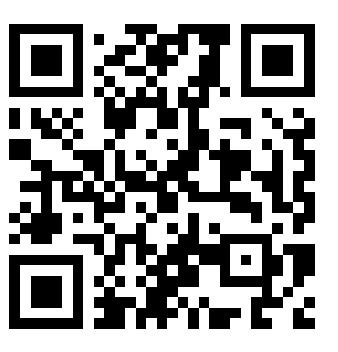
Magano Frietya
For more information into the work carried out by Development Workshop Namibia, explore our website at dw-namibia.org or simply scan the QR code provided.

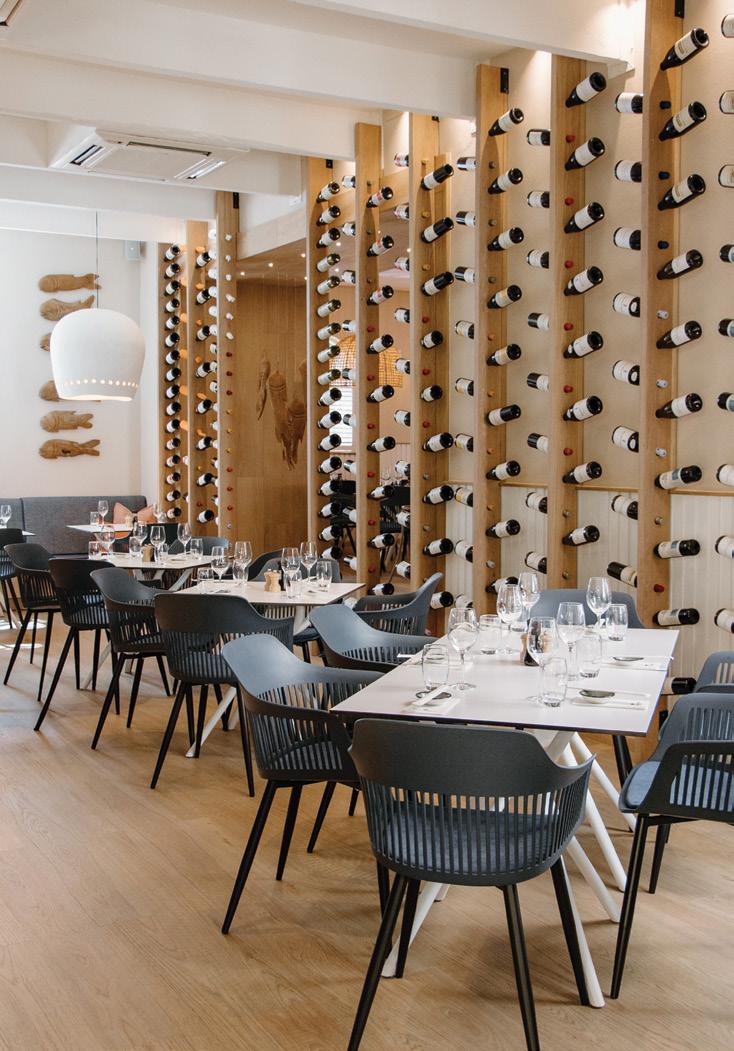








In the heart of Namibia’s capital city, a new culinary gem has emerged to tantalise sushi and seafood enthusiast’s taste buds. What makes this new opening even more exciting is that it is an addition to the Stellenbosch Restaurants family tree. The Stellenbosch Wine Bar and Bistro has wowed visitors for more than fourteen years, with their championing of perfectly prepared Namibian meat and first-rate South African wines, and is a staple among locals and tourists alike.
Now, under the guidance of the Windhoek Collections expert restaurateurs and hoteliers, a new restaurant has been welcomed to the fold, that being Donkiesbaai Sushi and Seafood. Donkiesbaai wines is owned by Jean Engelbrecht, who is one of the three owners of the Windhoek Collection, which includes the Stellenbosch Wine Bar and Bistro, the Stellenbosch Tasting Room, The Windhoek Luxury Suites and Hillside Accommodation. Donkiesbaai wines are named after the place where his family has holidayed for four generations. Their wines hail from the unassuming region of Piekenierskloof in the Western Cape, where a warmer climate and cool evening winds create a welcoming wine that is perfectly paired with seafood.
At the Donkiesbaai Sushi and Seafood grand opening event, a group of loyal patrons had the privilege of sampling the new menu, crafted by Chef Nick after a week of inspiration from a renowned sushi establishment in the Western Cape of South Africa. I was fortunate enough to be among those who savoured the offerings of this exciting new eatery, where each dish reflects the chef's commitment to culinary excellence.
Located in the former Stellenbosch Market space, a beloved neighbourhood coffee shop, the restaurant has undergone extensive renovations to emerge as a completely transformed
dining destination. During the evening's welcome remarks, Engelbrecht, shared that while the coffee shop once served a crucial role in the community, the market had become saturated with similar offerings. This realisation sparked their vision to reinvent the space, filling a gap for seafood-based fine dining experiences in the area.
Beyond its delectable bites of sushi, Donkiesbaai Sushi and Seafood offers an exceptional dining atmosphere characterised by bold yet tasteful decor. A personal favourite of mine is the wall with fish scale tiles, also known as mermaid tiles, adorned with giant fish motifs that add a whimsical touch to the space. That, and the oversized pendants resembling solid porcelain fish traps, casting a warm and inviting glow in the space.
Another exceptional highlight worth mentioning is the attentive staff, who go above and beyond to ensure your visit is truly memorable. Whether you're enjoying a romantic evening for two or celebrating with friends and family, this new restaurant is poised to become a cherished favourite.
What’s more, in keeping with what this location first became known for, even amidst its transformation, patrons can still savour a perfect cup of coffee. At the end of a scrumptious meal, I relished a cappuccino that continues to uphold the standards that initially earned this location its renown.
After sampling the opening night offerings, my verdict is that Donkiesbaai Sushi and Seafood is set to become a cornerstone of our city's dining scene. It will surely secure its place among Windhoek's best restaurants while it celebrates the flavours of the sea that pair so well with an excellent glass of wine.
Kirsty Watermeyer



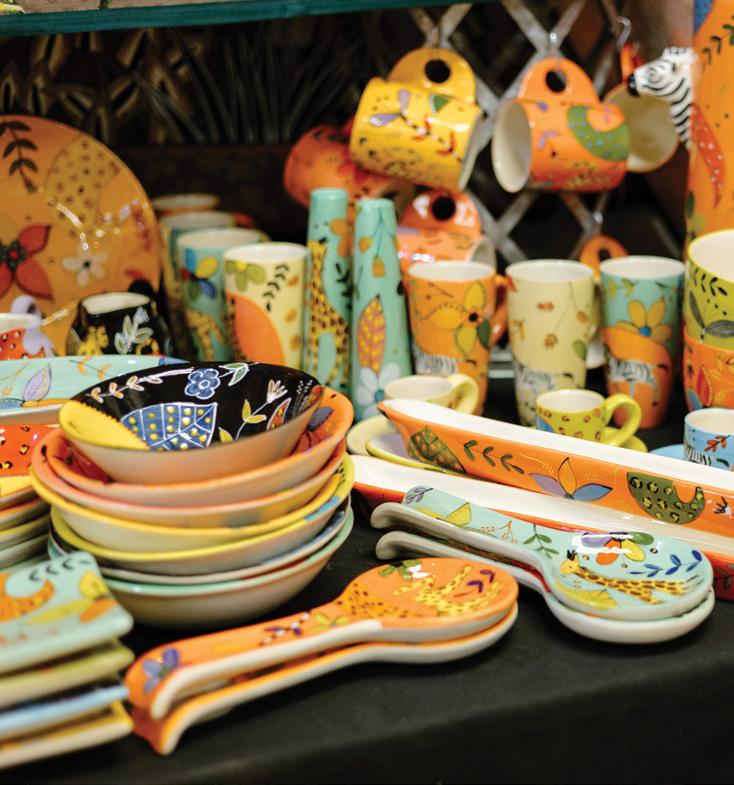



The Namibia Craft Centre has once again delighted locals and tourists alike with its annual "Christmas in July" exhibit. Now in its 13th year, the exhibit’s 2024 theme, "Welcome to the Jungle," promises an explosion of vibrant, African-inspired designs. This year’s event coincides with Namibia’s peak tourist season, attracting a multitude of international visitors eager to purchase unique, locally-made gifts.
The exhibit predominantly showcases the work of the I’KHOBA group, named after the San word for gemsbok. The I’KHOBA Textile Project involves over 400 women, each contributing one-of-a-kind embroidered pieces from the comfort of their own homes. This remarkable effort highlights intricate embroidery and beading, staples at the Craft Centre. However, a diverse array of other crafts is also on display, featuring designs inspired by the lush greenery, florals, and wild animals of the jungle. From striking ceramics to detailed home decor, there is something for everyone.
Mildred, along with her mother Karin and aunt Heide, have been the driving force behind this exhibit each year. Reflecting on this year’s theme, Mildred shared that it was
inspired by a similar concept from the COVID-19 era, a time when local support was crucial. Now, with tourism thriving again, they wanted to see the jungle theme flourish fully.
Creating a new theme annually is no small feat. Mildred explains that they continually challenge themselves, drawing inspiration from a year of collaboration and brainstorming. She finds joy in the surprise elements the artists bring to the exhibit, especially the embroiderers, who infuse their unique perspectives into their work.
Despite the challenges, including sourcing quality materials and the occasional failed idea, the team perseveres. Mildred’s advice for aspiring entrepreneurs is to stay persistent and seek advice wherever possible. This year’s exhibit, which runs until 31 August, is a testament to the rich cultural influences and regional artistry of Namibia. Don’t miss the chance to experience and take home a piece of this vibrant celebration.
Find the Omba Gallery in the Namibia Craft Centre at 40 Tal Street, Windhoek.
Suné van Wyk





In a significant stride towards sustainable development, the Ministry of Environment, Forestry, and Tourism (MEFT), in collaboration with the United Nations Development Programme (UNDP), is spearheading the Namibia Integrated Landscape Approach for Enhancing Livelihoods and Environmental Governance to Eradicate Poverty (NILALEG) Project ,which is funded by the Global Environmental Facility (GEF). This initiative aims to revolutionise land management practices across key agricultural and forest landscapes, integrating poverty reduction with environmental sustainability.
In alignment with their goals, the NILALEG Project, in collaboration with the International University of Management (IUM) - Faculty of Environment & Sustainable Tourism (FEST), recently hosted an annual national Integrated Landscape Management (ILM) conference in Windhoek. This conference brought together an array of stakeholders including government bodies, research institutions, and civil society organisations engaged in monitoring and reporting to international bodies like the United Nations Framework Convention on Climate Change and the United Nations Convention to Combat Desertification.
Speaking at the opening of the conference, Minister of Environment, Forestry, and Tourism, Pohamba Shifeta underscored the profound impact of environmental degradation on Namibia, affecting 70% of the population dependent on natural resources. He emphasised that the NILALEG project is pivotal in addressing these challenges by promoting integrated landscape management. Particularly, he highlighted the project's objective of restoring degraded lands to enhance drought resilience — a critical initiative given Namibia’s vulnerability to climate change.
UNDP Resident Representative to Namibia, Alka Bhatia, elaborated on the project’s successes, including sustainable practices such as the harvesting of Devil’s Claw, which has improved livelihoods while conserving natural resources. She also pointed to the integration of innovative digital tools such as geospatial technologies and drones, which play a crucial role in monitoring landscapes and guiding adaptive management decisions.
Shifeta commended the conference for facilitating dialogue among diverse experts, enabling the derivation of practical solutions to environmental challenges. "This approach balances conservation, agricultural practices, and sustainable development, with a strong emphasis on public-private partnerships (PPPs)," he added.
Bhatia noted that "the ILM Conference exemplifies Namibia’s commitment to environmental governance and sustainable development, ensuring that our natural resources support both present and future generations". She emphasised the conference's role in promoting partnerships, knowledge sharing, and the integration of scientific and indigenous knowledge — a cornerstone for advancing sustainable land management practices.
The conference proved a pivotal platform for knowledge sharing and strategic planning. Discussions encompassed the impact of climate change on Namibian landscapes, techniques for rehabilitating degraded areas, and the integration of digital tools for effective landscape management. Participants also explored public-private partnerships for nature-based initiatives. Consistent feedback from participants at the ILM Conference was the need to share what they had learnt here with a wider audience across Namibia, and many spoke of the fascinating discoveries and learnings they had uncovered here.
The NILALEG project and the ILM Conference are a testament to Namibia’s dedication to sustainable development. The conference helped lay the groundwork for sustainable land management practices that benefit both people and the environment and demonstrated that by fostering collaboration, innovation, and informed decision-making, Namibia is poised to achieve environmental resilience while uplifting livelihoods across its landscapes.
Kirsty Watermeyer
Spearheaded by the NILALEG project, that is implemented by the Ministry of Environment, Forestry and Tourism in partnership with the United Nations Development Programme and funded by the Global Environmental Facility.




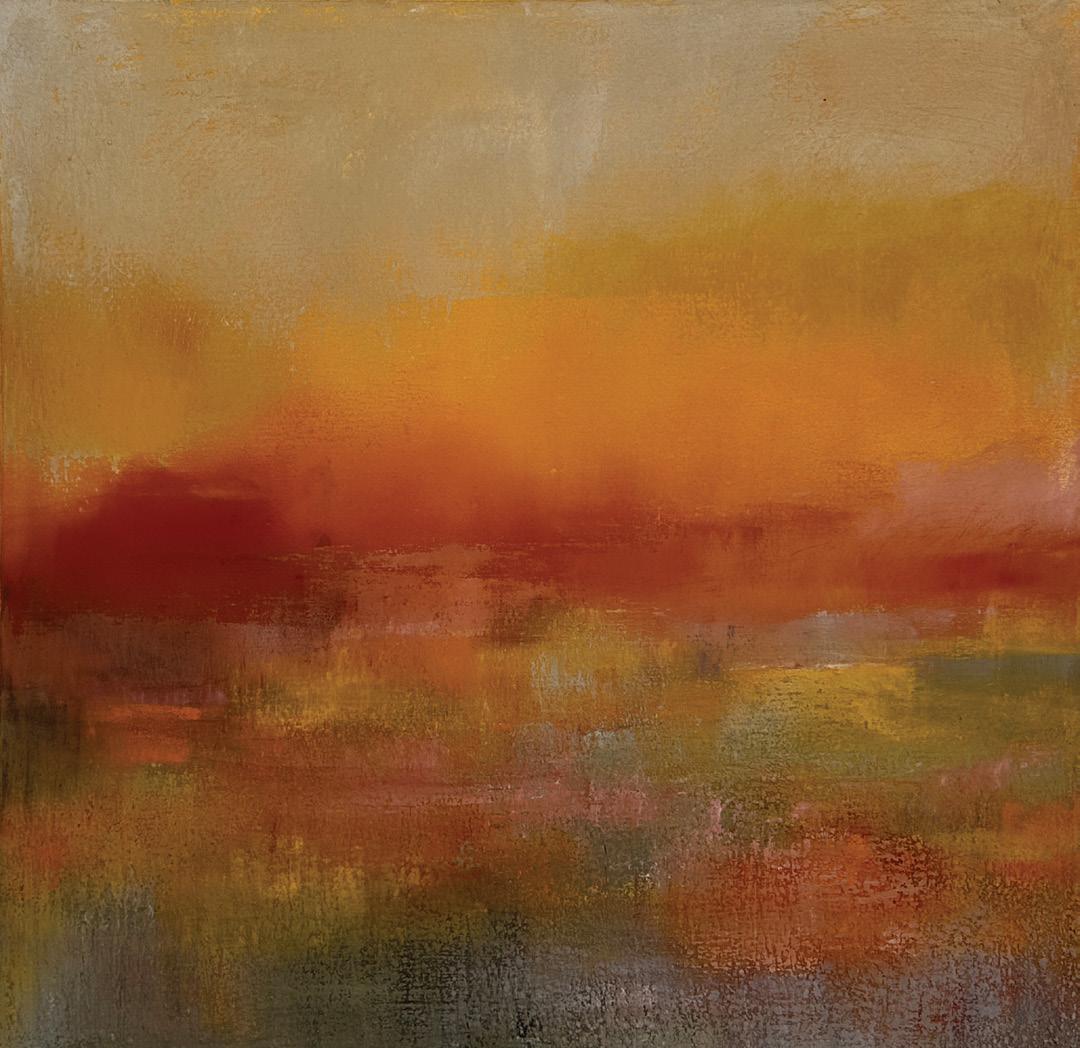



On 10 August, The Project Room in Windhoek will host the opening of The Time Between, a new exhibition by renowned Namibian artist Barbara Böhlke. Known for her evocative abstract paintings using natural ochre pigments, Böhlke is set to unveil a new collection of work that showcases her ever-evolving technique, combining representational and abstract elements while encapsulating themes of existence, memory and the natural world.
Böhlke’s use of ochre pigments, mined in northwest Namibia and traditionally used by the Ovahimba people for their otjize (a mixture of red pigment and butter that is rubbed onto the skin), has been a signature element of her art over the last few years. The pigments, combined with ash, charcoal and white acrylic paint, create a unique texture and colour palette that resonate deeply with her connection to the Namibian soil.
In The Time Between, Böhlke expands her artistic repertoire by reintroducing representational elements alongside her abstract compositions. This exhibition explores the dichotomy of existence – fleeting and seemingly insignificant in the grand scheme of the universe, contrasted with its immense, mysterious and invaluable nature. Böhlke eloquently expresses this theme by drawing inspiration from the life cycles of insects. “Insects, fragile and short-lived yet strong enough to fly, represent both our vulnerability and resilience,” she explains.
One of the highlights of the exhibition is Böhlke’s abstract piece, In Memoriam. This work features scribbles reminiscent of writings and drawings, serving as a poignant tribute to friends and family
she has lost. Böhlke reflects on the ephemeral nature of memory and how we honour the departed by remembering them, even as those memories eventually fade with us.
Another notable work, From Here to There, incorporates seed pods from the Terminalia tree in her garden. Böhlke describes the seed pods as embodying all the possibilities of life. Wintergrass, on the other hand, signifies the end of a cycle, which carries its own inherent harmony. Together, these pieces capture the essence of life’s cyclical nature and the continuous interplay between beginnings and endings.
Böhlke’s fascination with the origin of the universe also plays a significant role in her creative process. Stardust is inspired by the idea that every atom in our bodies was formed billions of years ago in the hearts of stars. This cosmic connection has continually intrigued her, permeating into her work and infusing it with a sense of wonder.
Throughout the collection, each piece is connected by Böhlke’s need to explore space, an inspiration set off by the endlessness of the Namibian landscape, ultimately evoking a deep emotional reflection. The Time Between promises to be a captivating exploration of the transient and resilient aspects of life, seen through the unique lens of Böhlke’s artistic perspective.
The Time Between opens on 10 August at 11:00 at The Project Room and will end on 7 September.

Nina van Zyl
Project Room - Namibia www.theprojectroom.com.na

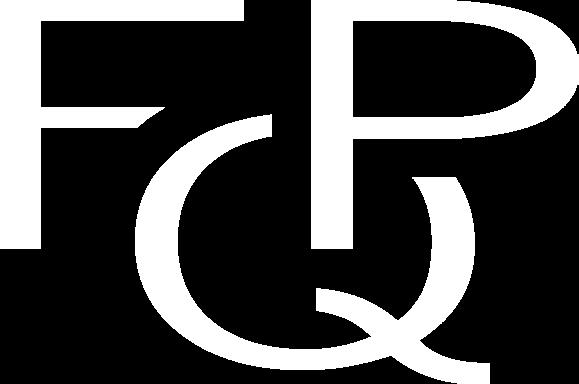


In a significant stride towards enhancing healthcare services in Namibia, Debmarine Namibia recently donated essential haemodialysis equipment to the Oshakati Intermediate Hospital. This generous contribution, valued at over N$ 1.7 million, includes three haemodialysis machines, three overbed tables, three dialysis chairs, and one reverse osmosis machine.
During the handover ceremony, Minister of Health and Social Services, Dr. Kalumbi Shangula, underscored the importance of such collaborations between the private sector and the government, adding that this sponsorship complements the ministry’s efforts to enhance healthcare services at the hospital. He emphasised that partnerships like these are crucial in augmenting healthcare quality and accessibility nationwide.
Dr. Shangula emphasised that the haemodialysis machines will not only ease the strain on current resources but also significantly elevate the standard of patient care. During the period from April 2023 to April 2024, the hospital handled 133 new haemodialysis cases, underscoring the critical necessity and impact of this equipment in treating severe kidney conditions. Out of these cases, 35 patients recovered, 38 are currently managed as outpatients, 27 chronic cases were referred to private facilities, and three patients relocated to other regions. Tragically, 30 patients succumbed to diabetes-related complications during this time.
Speaking on behalf of Debmarine Namibia, Communications Manager Stella Ipinge conveyed Chief Executive Officer Willy Mertens' commitment to corporate social responsibility. Mertens highlighted how their Social Investment Fund identified the urgent requirement for haemodialysis machines at the hospital, aiming to address healthcare disparities and improve patient outcomes. He highlighted the critical role these machines play in treating severe kidney failure by filtering waste, excess fluids, and toxins from the blood.
"As responsible corporate citizens, Debmarine Namibia remains steadfast in its commitment to advancing healthcare initiatives nationwide," affirmed Mertens. He pointed to a range of sponsorships and donations the company has provided across various regions and healthcare domains, emphasising their enduring dedication to public health. Mertens specifically highlighted contributions to the Katutura TB clinic, support for the National Suicide Prevention campaign, provision of COVID-19 equipment, participation in vaccine drives, and donations of wheelchairs and industrial laundry machines. He underscored Debmarine Namibia's profound respect for the healthcare sector, reflecting their recognition of its vital importance to the community.



SAM SHIVUTE HONORED AT AFRICAN ACHIEVERS AWARDS
Namibia Revenue Agency (NamRa) Commissioner Sam Shivute has been honored with an Excellence in Leadership Award at the recently held African Achievers Awards (AAA) hosted at the House of Parliament in the United Kingdom.
The 2024 AAA edition aimed to highlight and celebrate the remarkable achievements of Africans who are driving positive change across various sectors, including business, politics, education, and social development. Hosted by Baroness Verma, Member of the House of Lords, UK, this year’s edition was held under the theme, “Empowering Africa: Honoring Excellence in Leadership and Innovation.”
BON AT ADVANCED STAGE TO IMPLEMENT COUNTERCYCLICAL CAPITAL BUFFER
The Macroprudential Oversight Committee (MOC) of the Bank of Namibia is at an advanced stage of implementing the countercyclical capital buffer (CCyB) as an additional macroprudential tool to strengthen the banking sector’s resilience. BoN Deputy Governor Leonie Dunn said the CCyB is a macroprudential policy instrument that serves as a measure of protection for the banking sector against the build-up of systemic risks associated with periods of excessive aggregate credit growth.
“This buffer instrument is generally built during good economic times and used during economic downturns,” she said.
HARDAP, //KHARAS REGION BANK ON GREEN HYDROGEN TO BOOST DEVELOPMENT
Hardap Governor Salomon April is optimistic that the growth of the country’s green hydrogen sector will benefit
the region, including generating jobs and stimulating economic development.
“This pioneering initiative is expected to create 100,000 domestic jobs and position Namibia as a producer of some of the world’s most affordable green hydrogen, estimated at $2 per kilogramme,” Nedbank Group Managing Executive for Corporate Investment Banking Anel Bosman said.
In his address, the CEO of the Environmental Investment Fund of Namibia, Benedict Libanda, highlighted the increasing global demand for green hydrogen energy and outlined significant opportunities for banks and lenders to participate in this burgeoning sector. The Nedbank Namibia event brought together industry players to discuss the financing prospects, collaboration opportunities, as well as potential sustainable economic expansion opportunities within Namibia’s green energy and green hydrogen industries.

!GAWAXAB HIGHLIGHTS NAMIBIA’S POTENTIAL AT LONDON STOCK EXCHANGE
Bank of Namibia Governor Johannes !Gawaxab says the country’s stability and predictability are key factors in making the nation an attractive investment destination.
“Namibia’s modern financial system and well-developed legal regime contribute significantly toward building investor confidence. In these global turbulent times, Namibia’s stability and predictability make Namibia an attractive destination for investment,” said !Gawaxab.
Regarding price developments, the Governor noted that the monetary policy easing cycle is in the offing in Namibia with the repo rate being kept unchanged since June 2023. “Despite the limited monetary discretion because of the fixed
peg arrangement with South Africa, the Bank of Namibia has broadly kept rates at 50 basis points lower than those of the anchor country since December 2022, with a view to support the domestic economy,” he said.
However, looking ahead, Namibia’s real domestic product (GDP) growth is projected to moderate from 4.2% in 2023 to 3.7% in 2024 due to anticipated slowdowns in the primary industry, partly due to drought conditions.
“The biggest risks to Namibia’s growth prospects include the prolonged tight global monetary policy stance, geopolitical tensions, and China’s faltering recovery,” he said.

The Ministry of Mines and Energy (MME) announced it will conduct a N$5 million (€250,000) study on the feasibility of a cross-border green hydrogen pipeline between Namibia and South Africa. The study will be undertaken by the Green Hydrogen Programme of Namibia and follows the signing of a Memorandum of Understanding (MoU) between the two countries in May 2024 at the World Hydrogen Summit.
The envisioned pipeline would connect Lüderitz in Namibia to South Africa’s Northern Cape, with the potential for future extensions. Minister of Mines and Energy, Tom Alweendo, stated that the study will assess the technical, commercial, environmental, and social feasibility of the project, with a focus on environmental, social, and governance (ESG) best practices. The project brings together key players such as the Western Cape Tourism, Investment and Trade Agency
(Wesgro), the Northern Cape Economic Development, Trade and Investment Promotion Agency (NCEDA), the Namibia Green Hydrogen Programme (NGH2P), Gasunie Waterstof Holding B.V., and Climate Fund Managers (CFM) NL B.V.
NAMIBIA RECORDS OVER 863,000 TOURIST ARRIVALS IN 2023, AN 87.4% SURGE
The Ministry of Environment, Forestry and Tourism says Namibia’s tourism industry recorded 863,872 international visitor arrivals in 2023, an 87.4% increase.
According to the Annual Tourist Statistical Report for 2023, released Monday by Minister of Environment, Forestry and Tourism Pohamba Shifeta, this represents a significant growth from the 461,027 arrivals recorded in 2022. While the figures are still 46% below pre-pandemic levels of 2019, the recovery trajectory is promising.
“Out of the total inbound international tourist arrival numbers, 84.1% came specifically for holidays, 9.4% for visiting friends/ relatives, 4.2% for business travel and 2.3% were in transit to other destinations,” Shifeta said.
INTERNATIONAL CERTIFICATION TO BOOST LOCAL PRODUCE MARKET ACCESS
The country’s produce farmers, certified by the Namibian Agronomic Board (NAB), have earned the local Good Agricultural Practices (GAP) certificate. The certification assures quality throughout agricultural supply chains, boosting the credibility and market presence of local farmers’ produce on both domestic and international markets.
“All the farmers that are going to be recognised have met 100% major compliance criteria and 95% minor compliance criteria on the Primary Farm Assurance (PFA) standard requirements for food safety and hygiene. It helps producers gain gradual recognition by providing an entry level to Global GAP Certification,” Lorna Shikongo-Kuvare, the NAB’s General Manager for Regulatory Services, said.
“Wusten Micro Farming, Metropolis Investments, Orange River Irrigation Projects, Oribi Asset No. 1, and Agricon Mushrooms have been awarded local GAP certification,” Shikongo-Kuvare said.





We love seeing your journeys with FlyNamibia on Instagram. Keep Tagging!


My mom flew for the first time in her life (07.07.2024)
My mom will be 64 years old in a few days (24 July is her birthday). And in her whole entire life, she has never been on a plane. When you live the way some of us do, you accept that certain things are simply out of your reach, so it doesn’t even cross your mind. For instance, we’ve worried about basics all our lives, a N$4 for clinic fare, or N$20 to get to school and so on. With the big shift recently after we escaped domestic abuse and fled the home we had, our main focus has been just getting one zinc here one pole there to build us a decent shelter.
As much as I know that memories are important and adventures are wonderful, I consciously have to prioritise some things over others. If I was going to fly my mom out of pocket, it was going be when this season was over for us. It will be when I’ve financially recovered from carrying the load and responsibilities of the first child (that never really goes away). Like all moms, she’s amazing and very deserving of these beautiful things, but I truly couldn’t do it all like this for her. Thank you to @fly_namibia for bringing this day closer

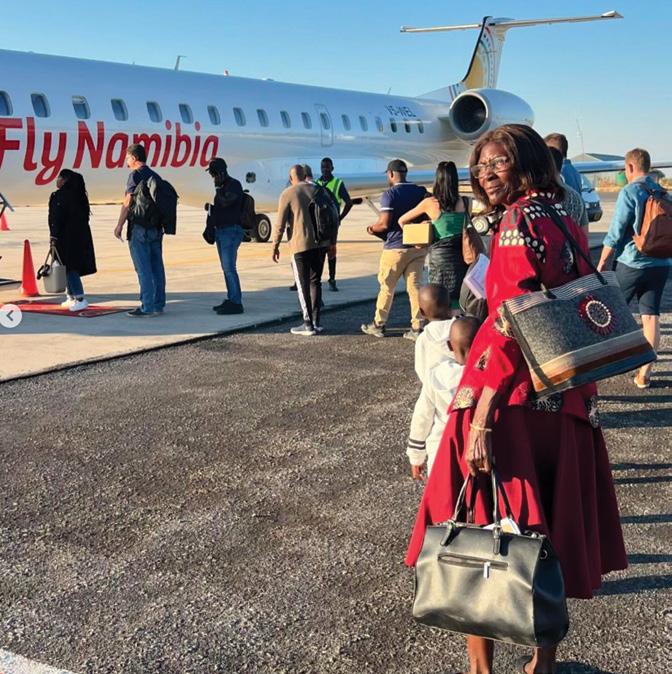
and making something like this that we’ve never even dreamt of come to life.
From participating in a Mother’s Day competition I saw here on Instagram to holding the tickets in my hands. It awes me every time. It’s like a dream you know.
In her own way, my mother is very thankful. I could tell it felt so surreal to her. After we’d checked in and passed security checks at the airport, she took out her bible and read out loud from Luke 1:46, and rejoiced “My soul magnifies the Lord, and my spirit rejoices in God my Saviour, for he has looked with favour on the lowliness of his servant”.
All these bring me immense joy and my eyes are filled with tears of joy, to have our generous airline do this for us. Omuwambo oha ti, waa pandula noyaka- otwa pandula unene FlyNamibia. Otwe mu tsila omungome guushimba ee.
I am grateful to have been able to also give my two boys a flight experience, and they accompanied Meme and I on this trip. God does wonders indeed.
We asked the FlyNamibia fam: "Tell us what your love about Namibia."






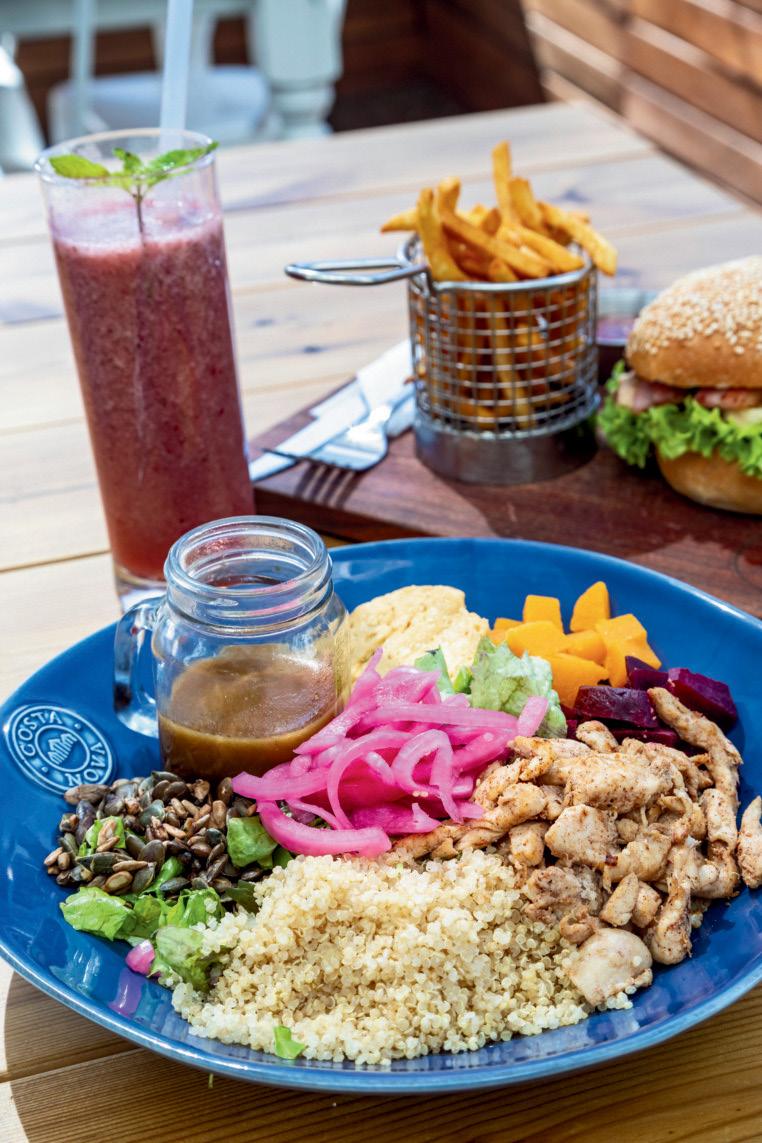
It is way more stressful to send your child to Grade 1 than to university.

This is a quote often heard from frustrated parents at my psychology practice.
Reaching readiness for learning at Grade 1 level involves a variety of complex systems and processes, which seemed a much more natural process to achieve a few decades ago. Today, early learning is hampered by an artificial lifestyle of sedentary electronically entertained preschoolers living on a diet of ultra-processed packaged foods. These children are then expected to process abstract information at a challenging speed at school... and then we wonder why they struggle.
It would seem that we need to get back to a natural process of preparing our children for the challenges ahead. Preschoolers need to develop an awareness of where they are in space (proprioception) in order to be agile, coordinated in movement, and having a good sense of direction. They need to develop their sense of balance (vestibular function) in order to control and strengthen their core muscles to keep them upright for extended periods of time and to control the fine muscles in their eyes and hands for reading and writing. They also need to fine-tune crossing their midline in order to use their whole brain for learning, especially when it comes to whole-brain subjects such as mathematics. Rolling, jumping, climbing, catching, throwing, kicking and dancing are thus of the utmost importance when our children are getting ready to learn on an abstract level in Grade 1 and beyond.
As their physical system is maturing, our children’s brain can have the opportunity to develop to its full potential,
understanding and remembering visual and auditory information and being able to represent it verbally and on paper with confidence and enjoyment. All people, and especially our young ones with ultra-fast brains, need to enjoy and be excited about learning as part of the everevolving nature of being human.
We, including our children, need to go back to the basics of eating natural food, moving until we are too tired to keep our eyes open and then dozing off into a deep restful sleep, getting us ready to move, learn and think again the next day.
Being excited about every new learning at hand and then having the energy to explore other interesting avenues is the ultimate gift we can offer to our learners of the future! Provide them with the necessary fuel and opportunities to move – physically and cognitively.
Dr Marelise Calitz Educational Psychologist
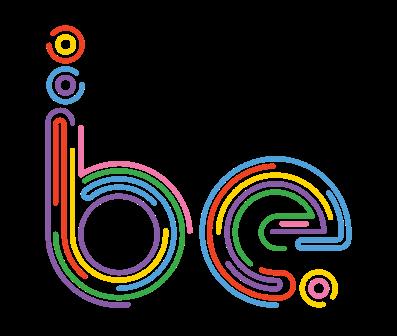


I vividly remember the first time a post came across my social media, boasting a beautifully saturated image of a quaint, picturesque town on a hilltop exclaiming: “Buy a house in Italy for €1.” Hook, line and sinker they got me, alongside arguably a large portion of the globe’s romantics, pasta-obsessed and cheapskates. Immediately I began doing research, hell-bent on the idea that my life-long dream of owning property in one of Europe’s most culturally rich countries might finally come true.
It turns out to be one well-marketed loophole. The oneeuro home initiative kicked off in 2019, and soon enough, dozens other municipalities of increasingly deserted villages began selling the abandoned, historic houses for a symbolic €1. The aim of the project is to revive these rural, old towns, as they face a demographic crisis. Declining youth population, extremely low birth rates and economic hardship has sent the buildings into rapid decay. In the regions of Sardinia, Abruzzo, Molise, Tuscany, Piedmont and more, the locals faced the threat of their once lively, cobblestone streets becoming desolate and abandoned.
In late 2020, the programme became an internet sensation off the back of a YouTube video, and subsequently, many people braver (or perhaps more foolish) than me ventured
to claim their piece of the Italian countryside lifestyle. By doing so, the idyllic little villages would get a new lease on life, preserving their cultural heritage and boosting the local economy.
What a concept!
HERE IS THE CATCH
Because they cannot possibly give them away for free, the €1 you pay for a small home in these rural municipalities is symbolic. Then comes the purchasing cost that can range from N$ 20,000 - N$80,000. As a guarantee that the buyer will renovate the house to historic standards, you must pay a deposit of between N$ 60,000 - N$140,000. Oh, and most of the towns set a timeframe of 2-3 years for the renovation to be completed.
Bada-bing bada-boom, you’ve laid down roughly N$130,000. Which, if we’re being completely honest, is still quite a bargain in this economy. The renovation, however, will cost you much, much more.
Keeping in mind that some of these homes have been sitting empty, slowly decaying for decades, you are buying into lots of hard work to make it remotely habitable. There are some beautiful homes out there, their charm being the historic architecture and quaint Italian towns they are located in, but an eye for potential is absolutely crucial. While websites such as case1euro.it and renovita.net show some pictures of your potential new property, the proof really is in the pudding. Most municipalities actually require that you visit the village first and view the houses on offer before you lay down that hefty €1.
That’s right folks, you may not buy the property and renovate it just to rent it out or use it only as a summer holiday home. The whole premise of the one-euro home initiative is to contribute to the local economy, so consider yourself at home in rural Italy for at the very least five years. You have to commit to using the property as your primary residence or opening a business there. Some municipalities might also require a minimum income or assets, and even having to learn Italian.

When all is said and done, buying a one-euro home in Italy promises to be the adventure of a lifetime if you’ve got the guts and grit for it.
Due to the fact that you are buying a piece of historic architecture, most of the municipalities demand that you restore the property to its supposed former glory. While there is room to tweak the renovations to your liking, it is imperative that the homes maintain their classic Italian style. The contractors and builders at your disposal in these rural areas might also be a challenge, hence many new owners endeavour to DIY the build as best they can.
Worlds away from scrolling through a real estate website with photos of properties from every angle, finding your oneeuro home is much more like firing a shot in the dark. First, find the names and websites of the municipalities taking part in this programme. It is not as simple as googling “€1 house in Italy for sale”. You will have to do a little digging to find these particular websites, but thelocal.it seems to offer the most comprehensive list and links to comune websites. Once you have found the municipality where you would like to invest, the next step is to express interest in their one-euro home scheme by emailing them directly.
Believe it or not, an overwhelming interest in these homes means you might have to join a waiting list. If you are planning to open a commercial activity like a B&B, bakery or other artisanal offerings, you might be fast-tracked to getting the property. Once you get the green light and secure an old home, a whole lot of paperwork follows. From getting your renovation plans approved to obtaining a visa, it is quite a tedious process.
When all is said and done, buying a one-euro home in Italy promises to be the adventure of a lifetime if you’ve got the guts and grit for it. Not only could you have your own slice of a charming little town in the countryside, but the community you may help revive has the potential to be life-enriching. There are plenty of people who have documented the process from start to finish on YouTube, candidly showing the realities of an undertaking as bold as this. But if all else fails, you can scratch the entire idea and simply buy a somewhat-habitable home in one of these old towns for upwards of half a million Namibian dollars.
Charene Labuschagne




Do we really understand happiness?
Neuroscientists are challenging traditional views on happiness, arguing that it extends beyond mere emotional states like joy and contentment. They are suggesting that this is old thinking and are highlighting that the part that we are missing is that in our world of duality, often our happiness is intertwined with strife and struggle and that this gives meaning to our joy. This perspective challenges the simplistic notion of happiness solely as a state of continuous pleasure, highlighting its dynamic relationship with adversity and personal growth.
Parenting provides a great example of the complex nature of happiness. Many people cite their children as a profound source of their joy and fulfilment, yet simultaneously acknowledge the challenges and exhaustion that come with parenting. This paradox is at the heart of the emerging New Happy movement, a scientifically informed philosophy gaining traction on social media. Stephanie Harrison, author of the book The New Happy, slated as a book to watch in 2024, delves into this paradox by suggesting that some of life's most meaningful and fulfilling moments are intertwined with difficulty.
Speaking to the Big Think, Harrison notes that “we have gotten happiness all wrong as a society, and if we have a flawed definition of happiness, then we will engage in behaviours that ultimately end up leading us astray.”
Perhaps to understand happiness, we need to look at the things we pursue to feel happy. Are these things material items, or possibly the perception of success and perfection? In a world that is being propelled by influencer culture, a dangerous narrative has been woven into our societal fabric, compelling us to desire things we don't truly need and perpetuating an unattainable standard of perfection. This lifestyle has undermined our sense of contentment and selfacceptance. If we have as a society pushed forward towards material wealth and other worldly successes, then it’s true that we have misunderstood the pursuit of happiness.
Since 1938, the Harvard Study of Adult Development has been investigating what makes people flourish, making this the longest in-depth longitudinal study on human life ever done. What they found out is that there is a strong correlation between deep relationships and well-being. These are not just our relationships, but the truly and deeply meaningful ones. Our most meaningful relationships are the ones with the people who are like a tonic for our soul.
Spending time with them is to refresh or energise one. Now ask yourself, how much of your life you spend with these people. Is it every day, every month or maybe only once a year? The answer to this question will give you insights into how much you are feeding your happiness.
We don’t always put our relationships first, despite research highlighting their significant benefits. Consider this, as inherently social beings, our relationships serve as mirrors, reflecting aspects of ourselves that may be challenging to confront but are essential for personal growth.
The coming months can be stressful for many, with the pressure of the year taking its toll. As we contemplate our own lives, don’t be afraid of the difficulty, it is a necessary part of life. Most people define happy times and difficult times as opposite, but they aren’t.
The dynamic interaction of happiness and sadness creates emotional contrast, enhancing our lived experiences. Similar to how light and dark are essential for perceiving depth and dimension, happiness, and sadness together add layers of complexity to our inner world. In their full spectrum, emotions define our humanity, and we can’t welcome the sweetness of joy without the knowledge that sweetness exists because bitterness does too.
Kirsty Watermeyer




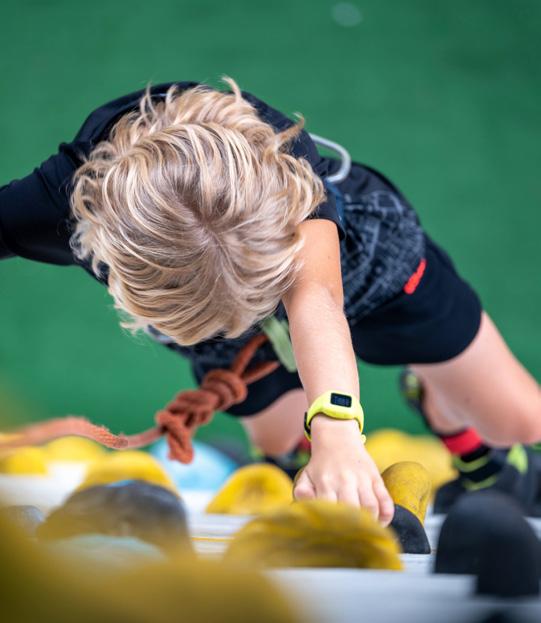

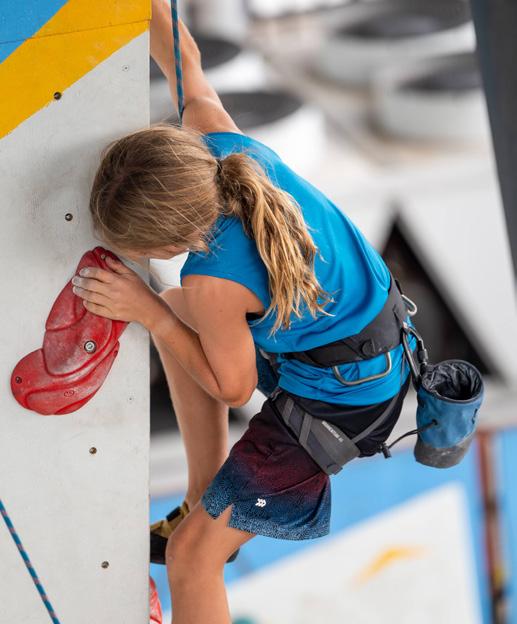



Anne Frank wrote her last diary entry. "[I] keep on trying to find a way of becoming what I would like to be, and what I could be, if...there weren't any other people living in the world." Three days later, she and her family were arrested and sent to Nazi concentration camps.

The first edition of The Guinness Book of Records was published on 27 August 1955, and printed 50,000 copies in its first year. By December of the same year, the book had already become a bestseller in the United Kingdom.

August is named after Augustus Caesar, founder and the first emperor of the Roman Empire. He renamed the month Sextilis after himself, as it was the month in which he achieved many victories.
The first telegram made it around the world in just 16 minutes and 30 seconds. The first telegram was sent from the New York Times office in order to discover how long it would take for a message to cross the world by telegraph cable. The message simply read “This message sent around the world”. The reply to the message was received by the New York Times office just 16.5 minutes after being sent.

Martin Luther King Jr gave his famous “I have a dream” speech on the steps of the Lincoln Memorial in Washington D.C. to 250 000 people listening.

In a standard year, there is no other month that begins on the same day as August begins. It’s only in a leap year, where the months of August and February begin on the same day.

The Mona Lisa was stolen in France. Vincenzo Peruggia decided to steal the 16thcentury painting by Leonardo da Vinci, after being employed by the Louvre to construct protective glass cases for some of the museum’s most famous works. Peruggia spent the night in a closet and proceeded to hide the Mona Lisa under his clothing. After finding that the museum was locked, he was let out by an unsuspecting plumber. The painting was reported missing 24 hours later. In 1913, the Mona Lisa was recovered, and Vincenzo Peruggia received a sevenmonth jail sentence.




August is also the month in which rock and country music legend Elvis Presely died in 1977 on the 16th.

August’s birthstone is peridot.


The goal of Sudoku is to fill a 9×9 grid with numbers so that each row, column and 3×3 section contain all of the digits between 1 and 9.
As far as the eye can see | The views from atop Grootberg in Namibia's northwestern Kunene Region astound. This rolling landscape, where the valley gives way to flat-top mountains in the hazy distance, is home to special wildlife populations, enigmatic cultures and Grootberg Lodgeowned by the local conservancy and managed by Journeys Namibia.




NAC hosted the successful Aviation Development (Aviadev) Africa 2024 at Movenpick Hotel in Windhoek from 19-21 June 2024.
NAC is optimistic and convinced that we will start to see renewed and strengthened commitment to implementing strategies for making the aviation sector a powerful source of managing our people’s social and economic development efforts in Namibia and Africa.
Special Thanks to the Government of the Republic of Namibia, Gondwana Collections, Namibia Civil Aviation Authority, Namibia Tourism Board, FlyNamibia, and many other local and international players for making this event a huge success!
Find us at and www.airports.com.na








